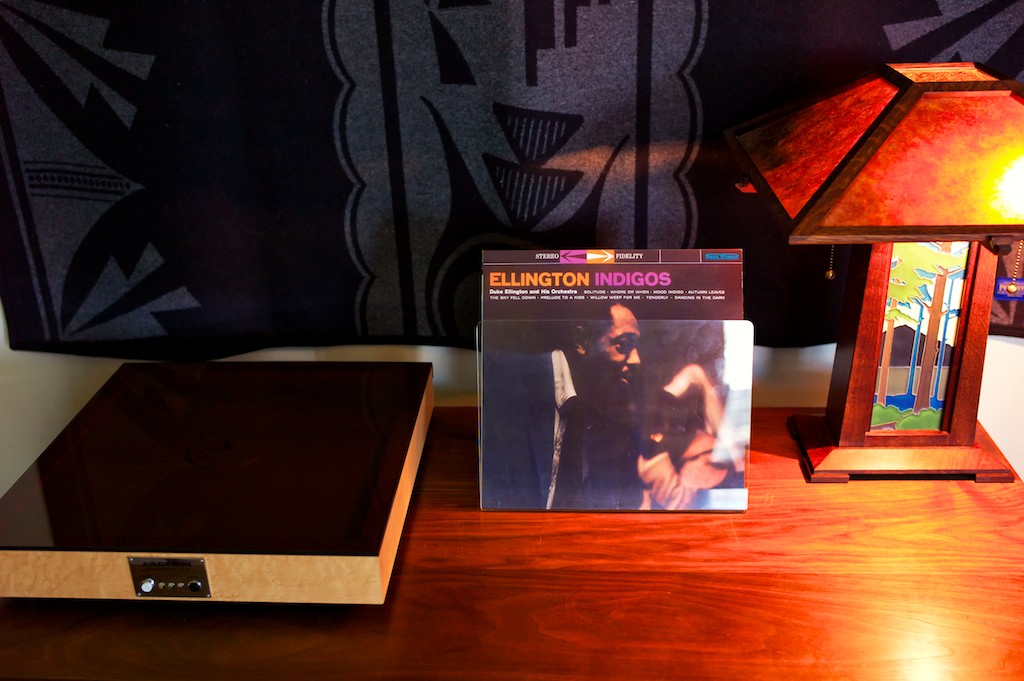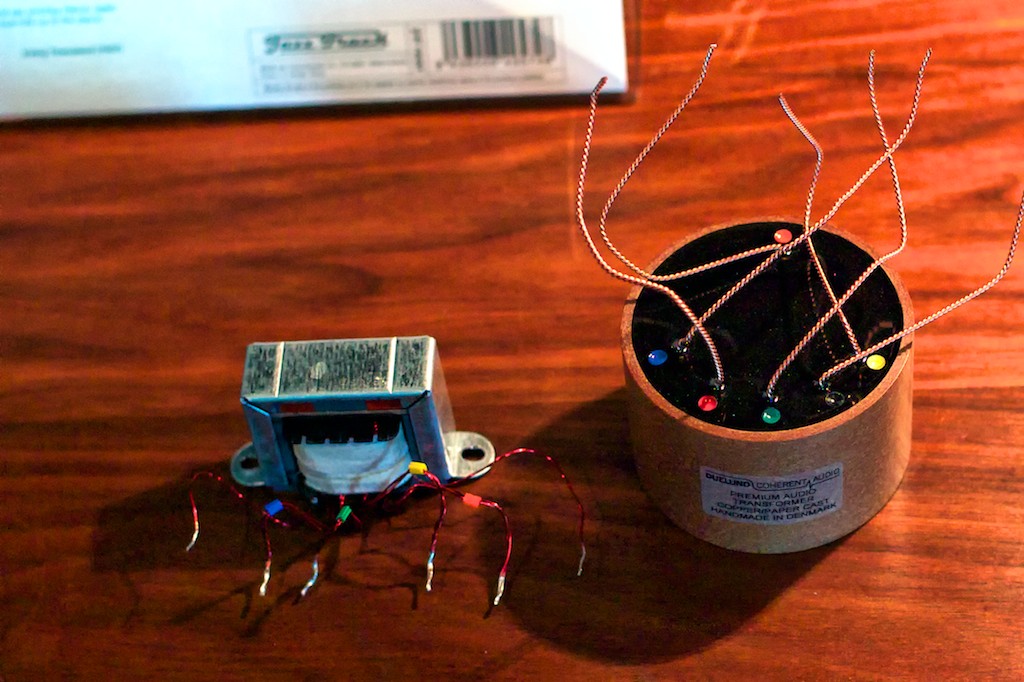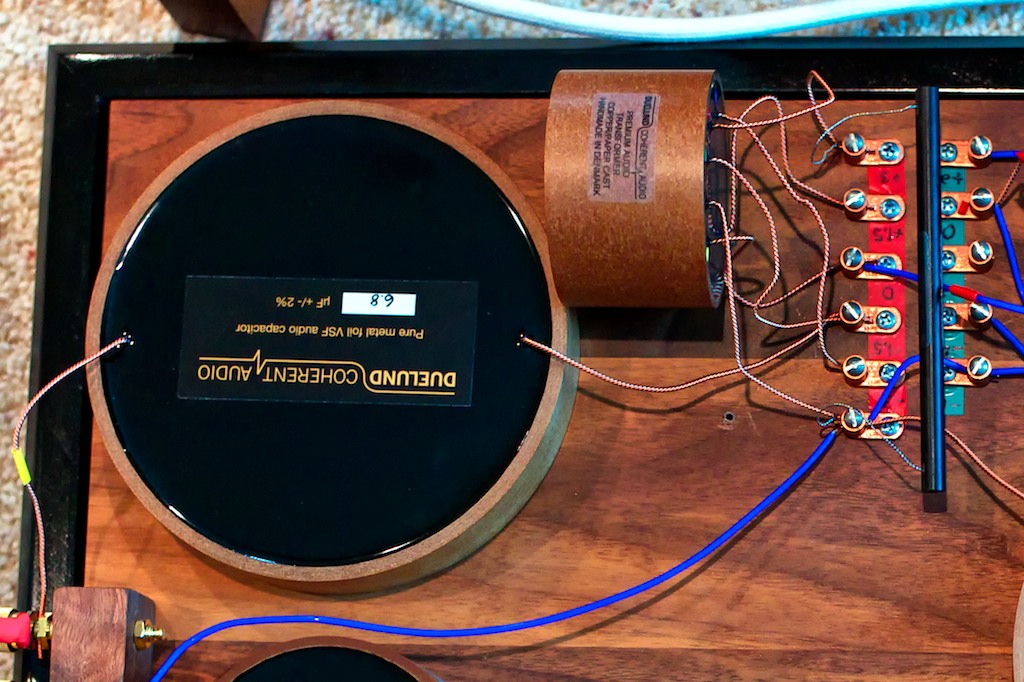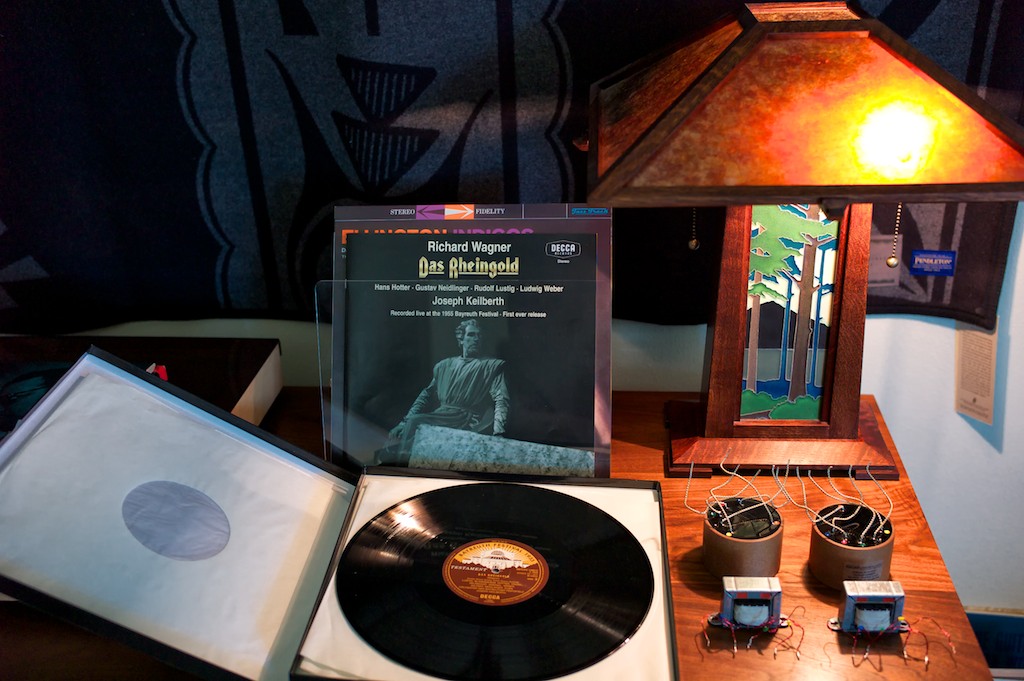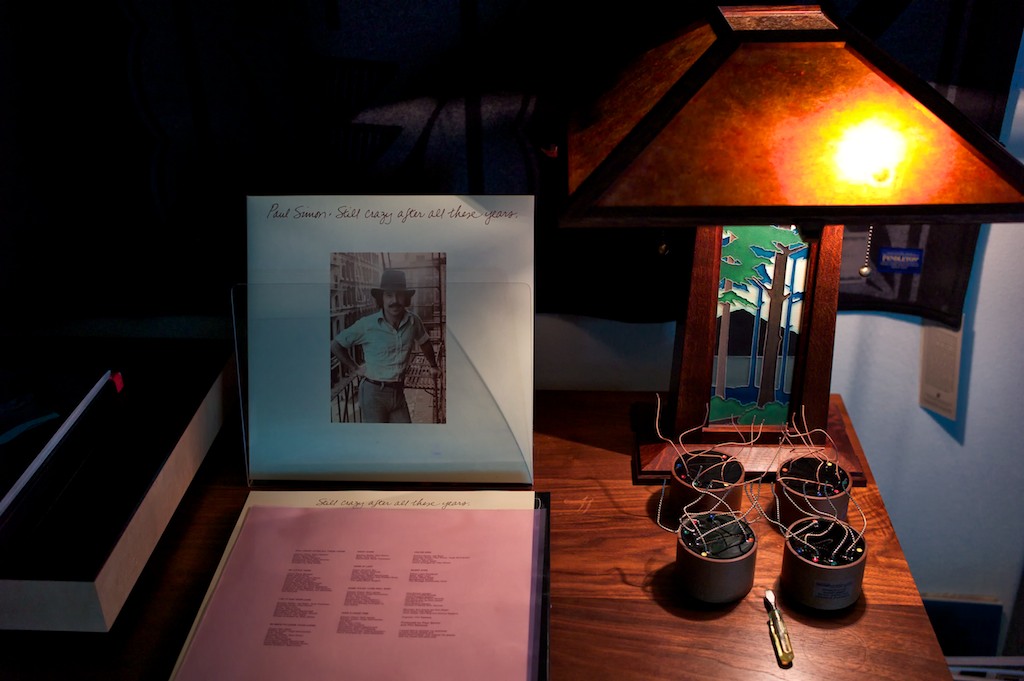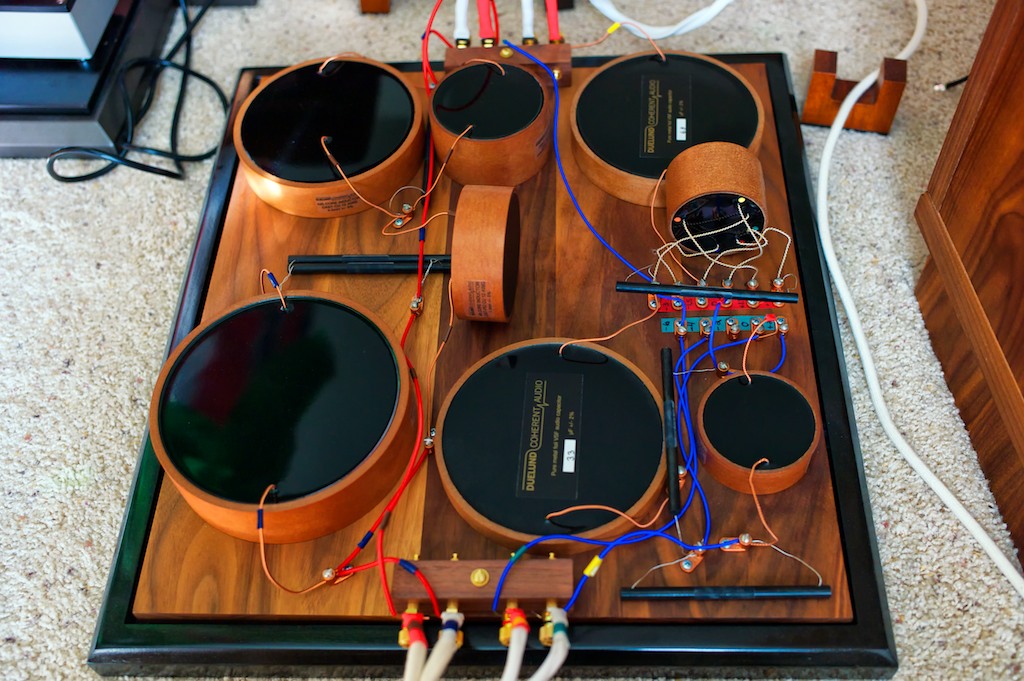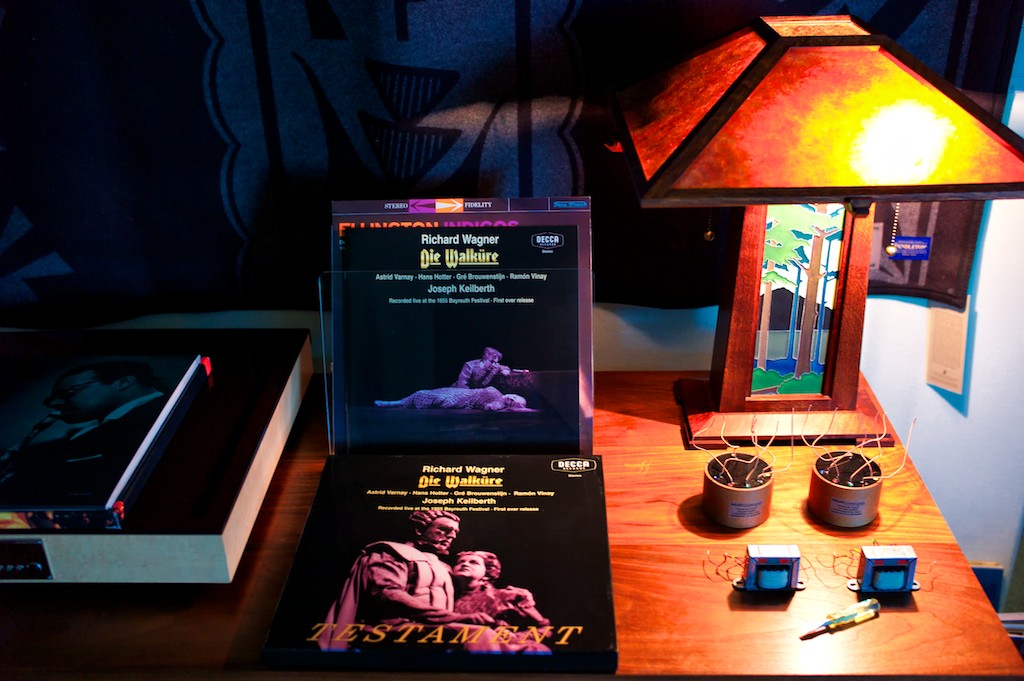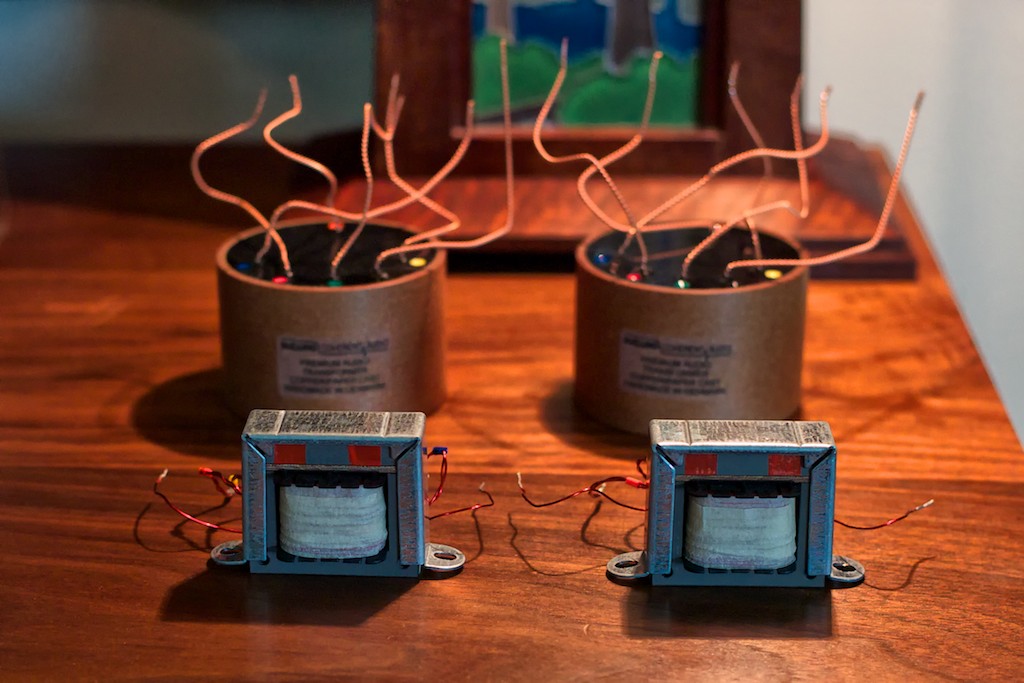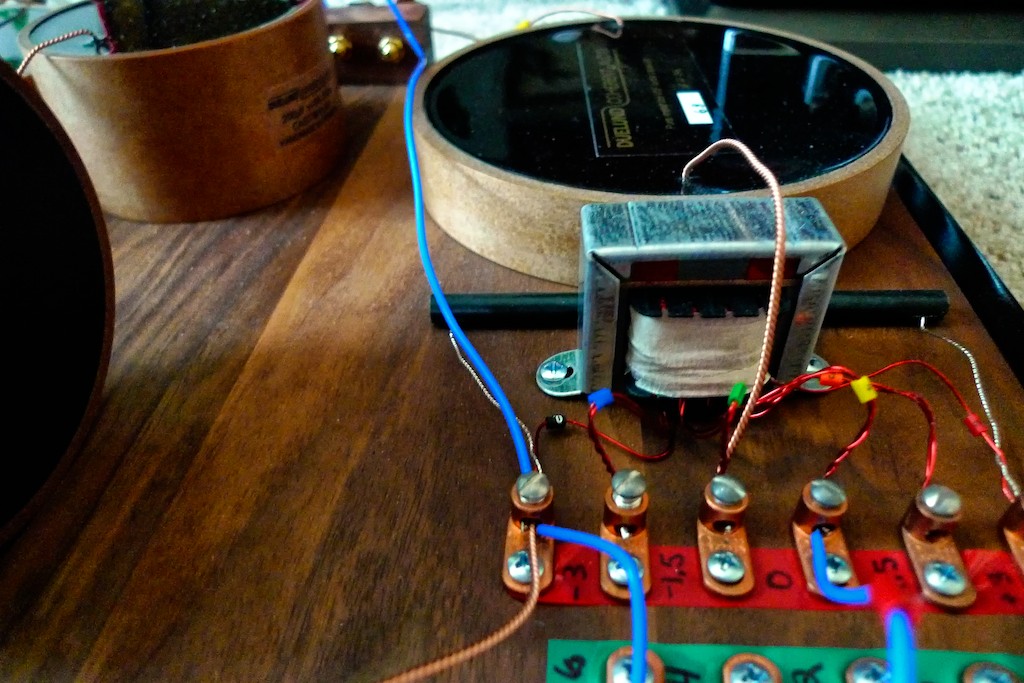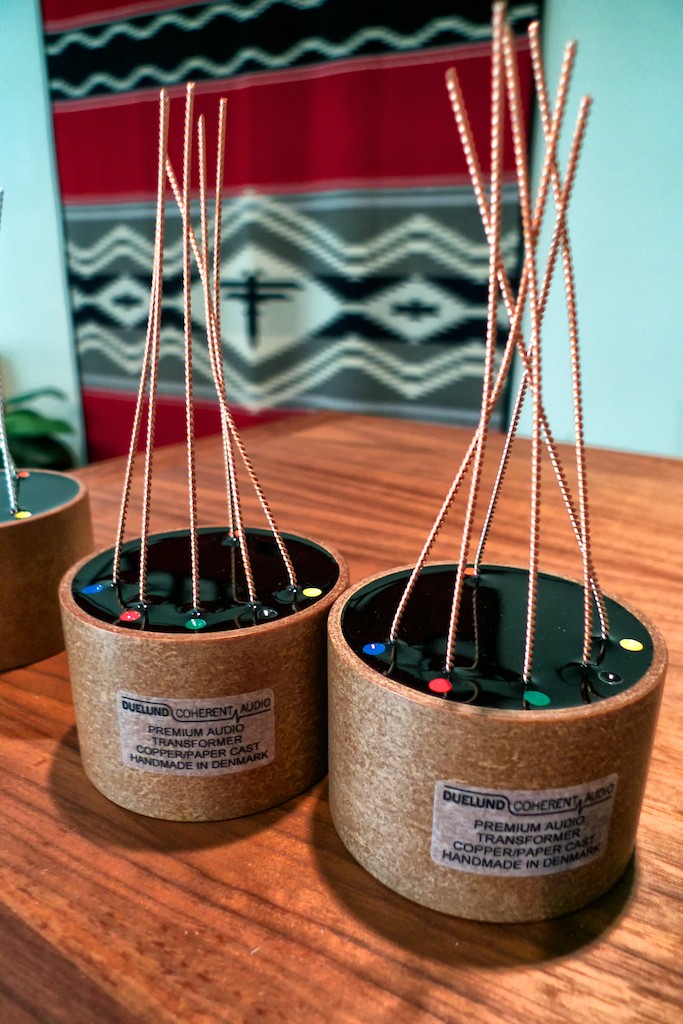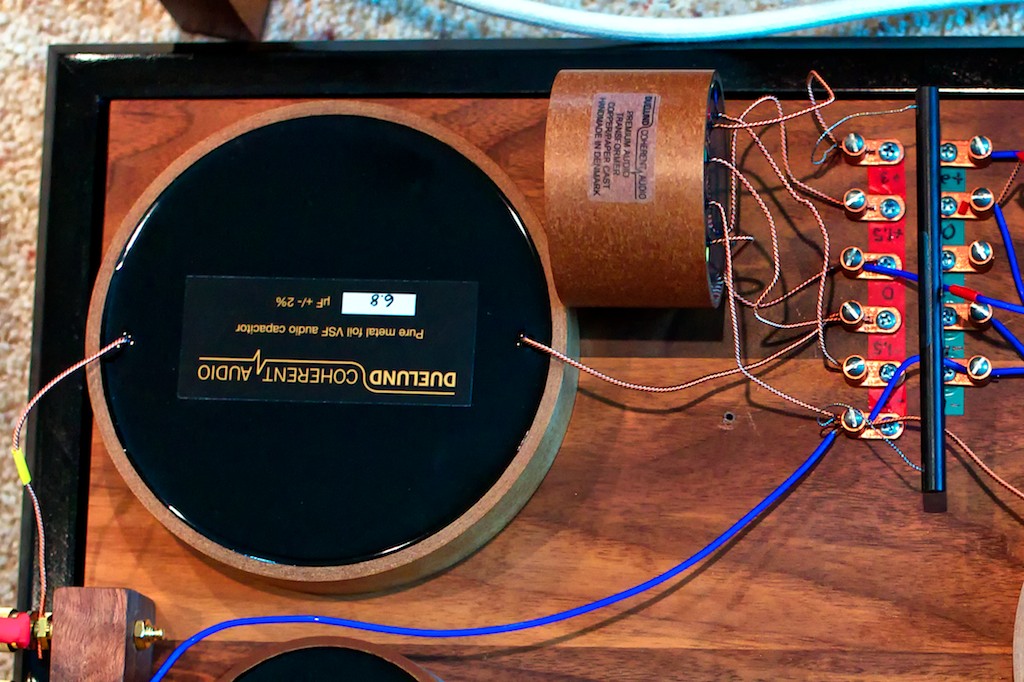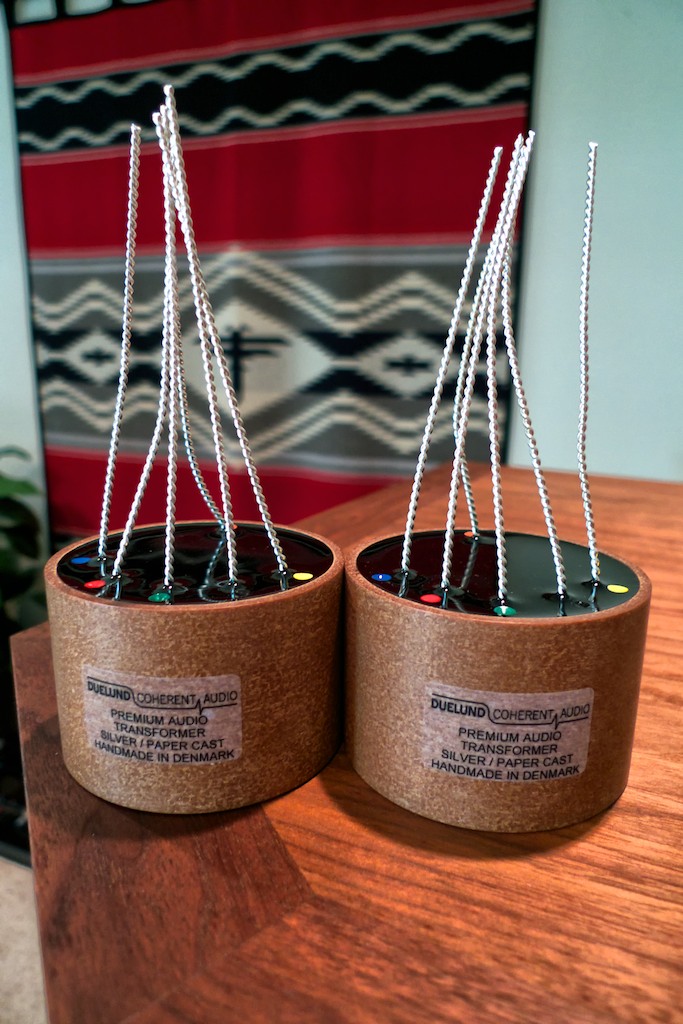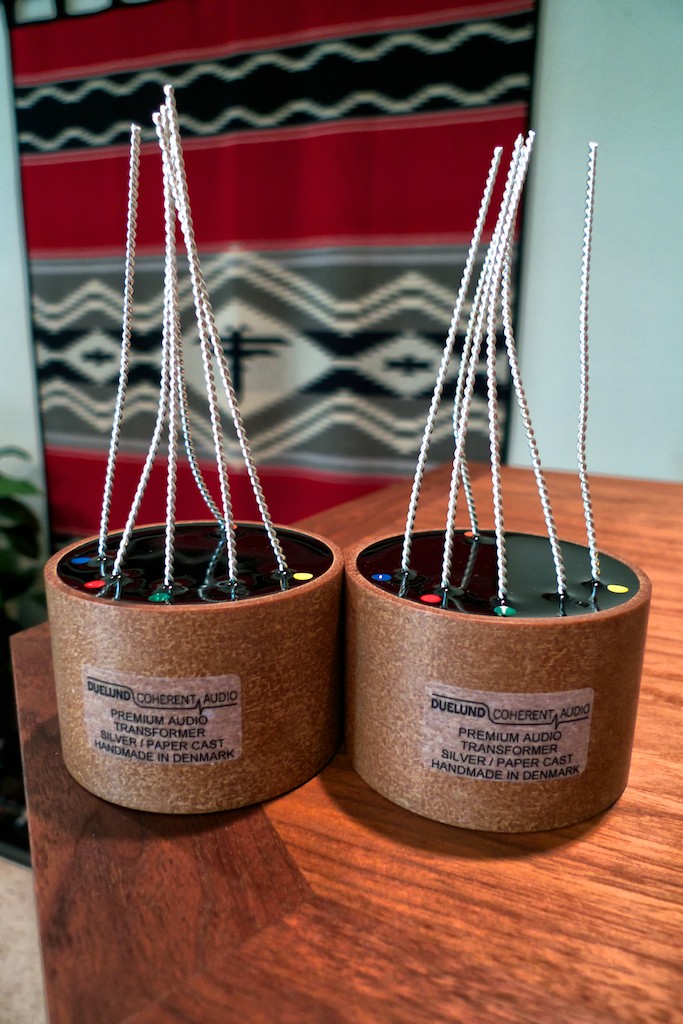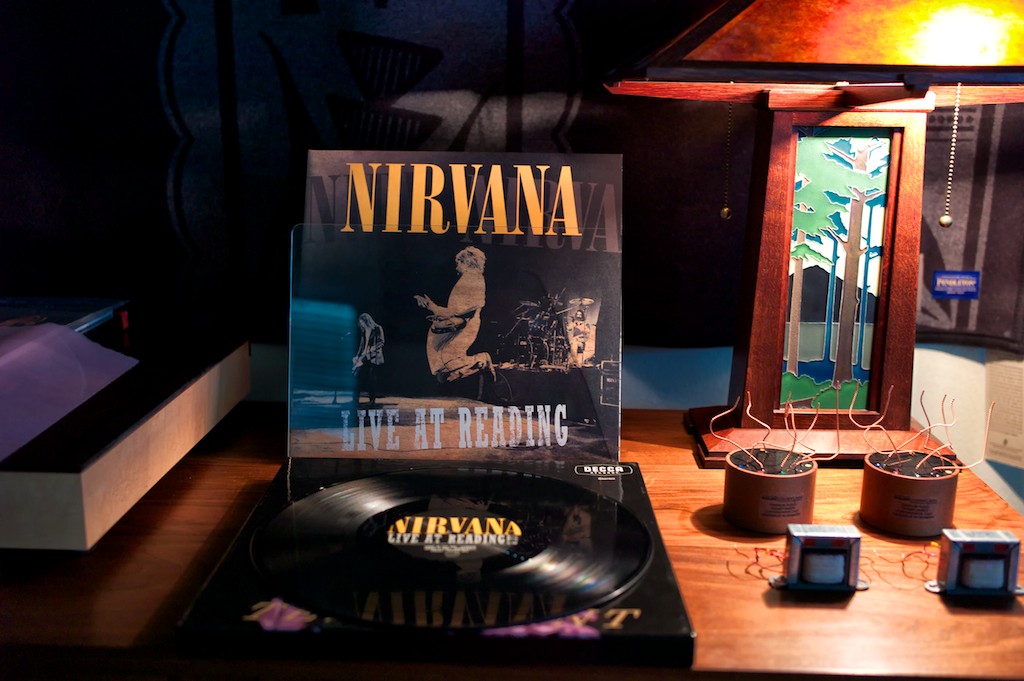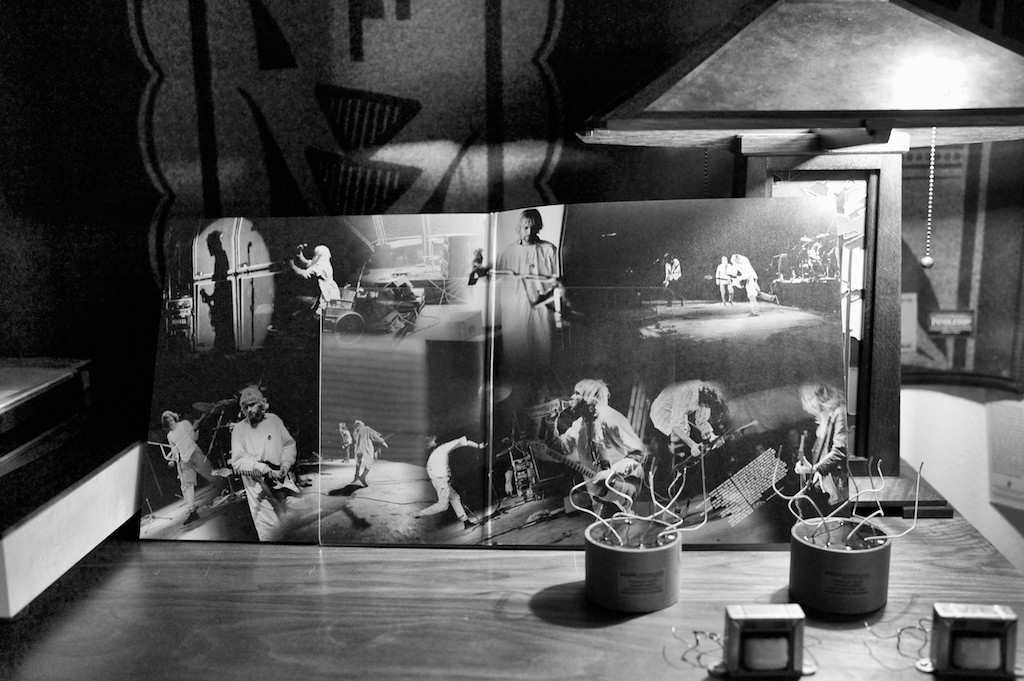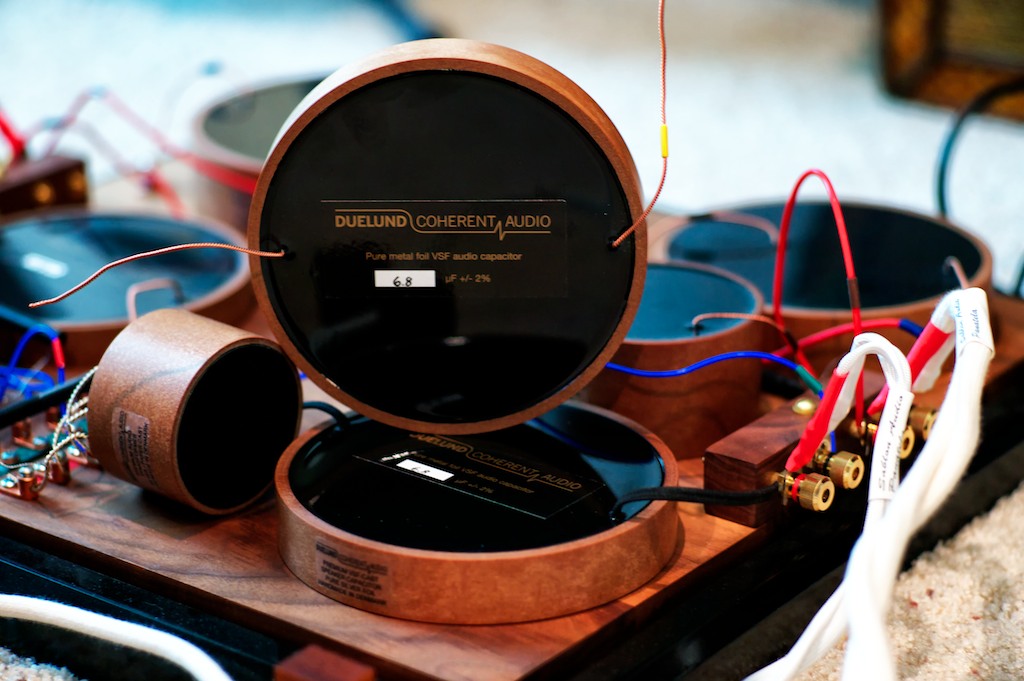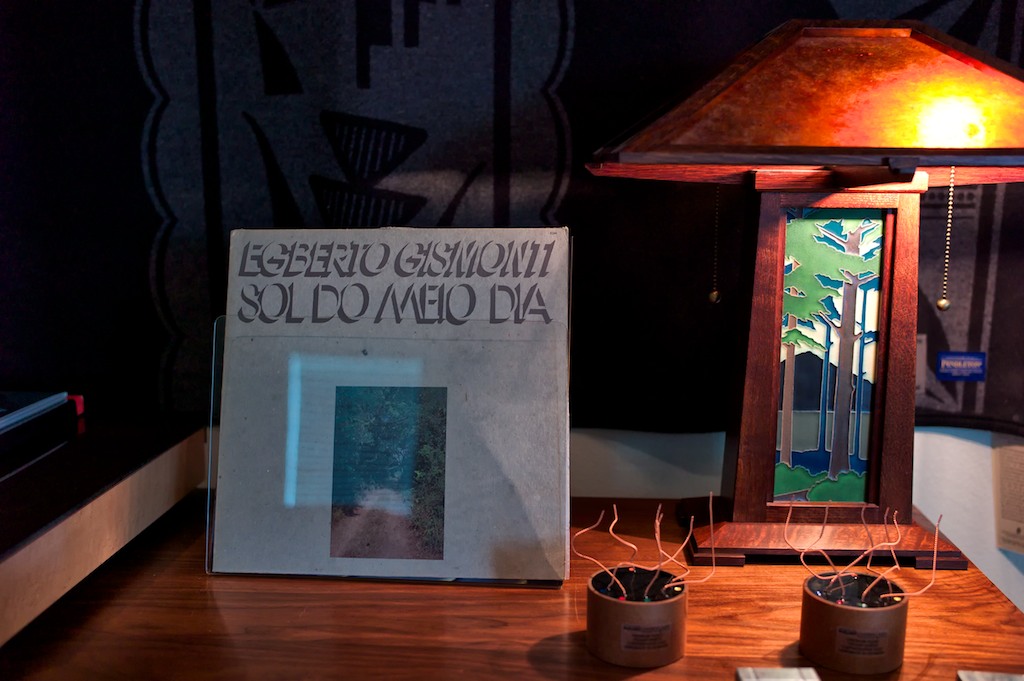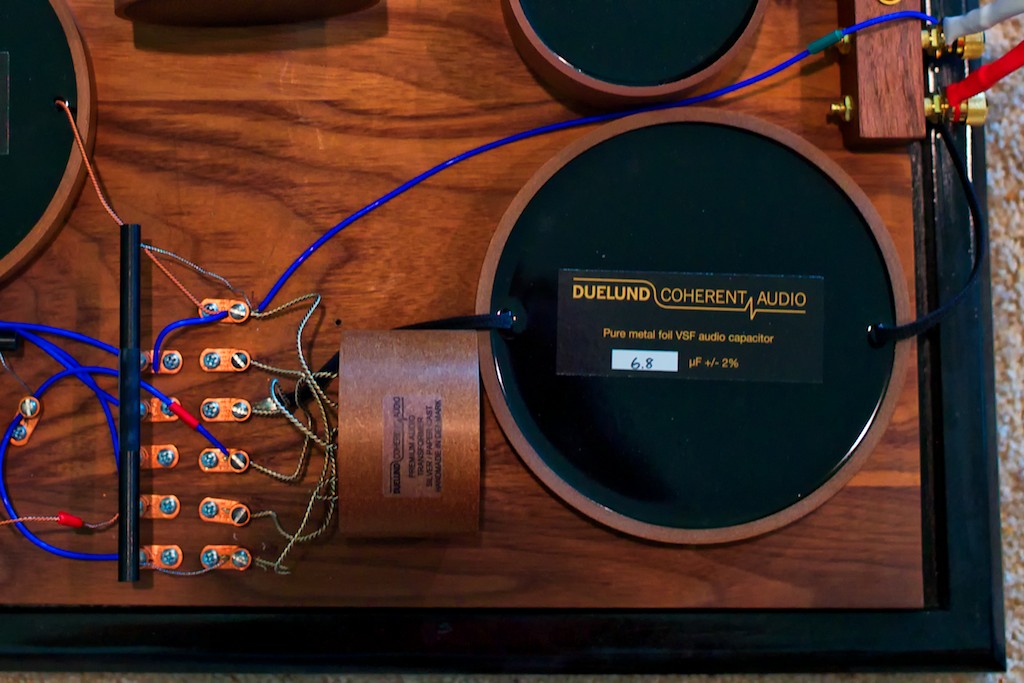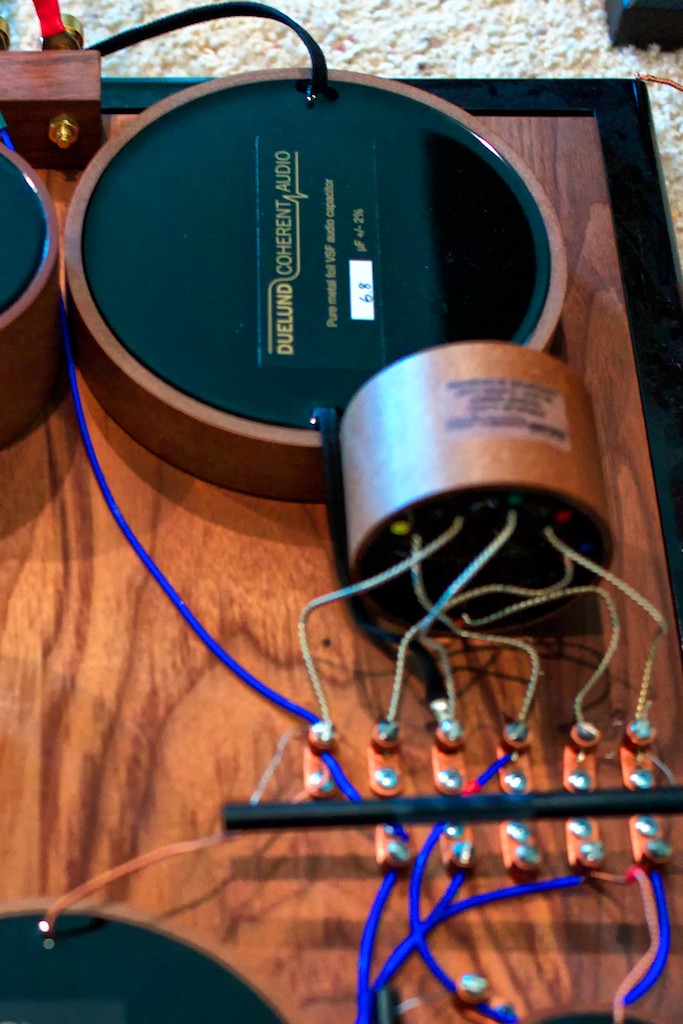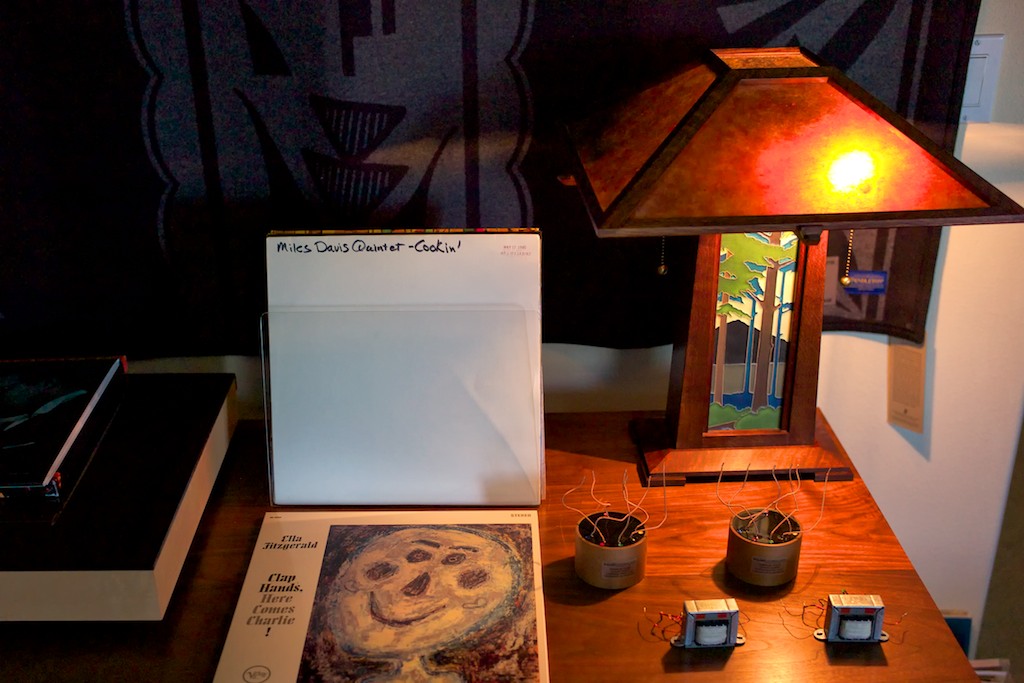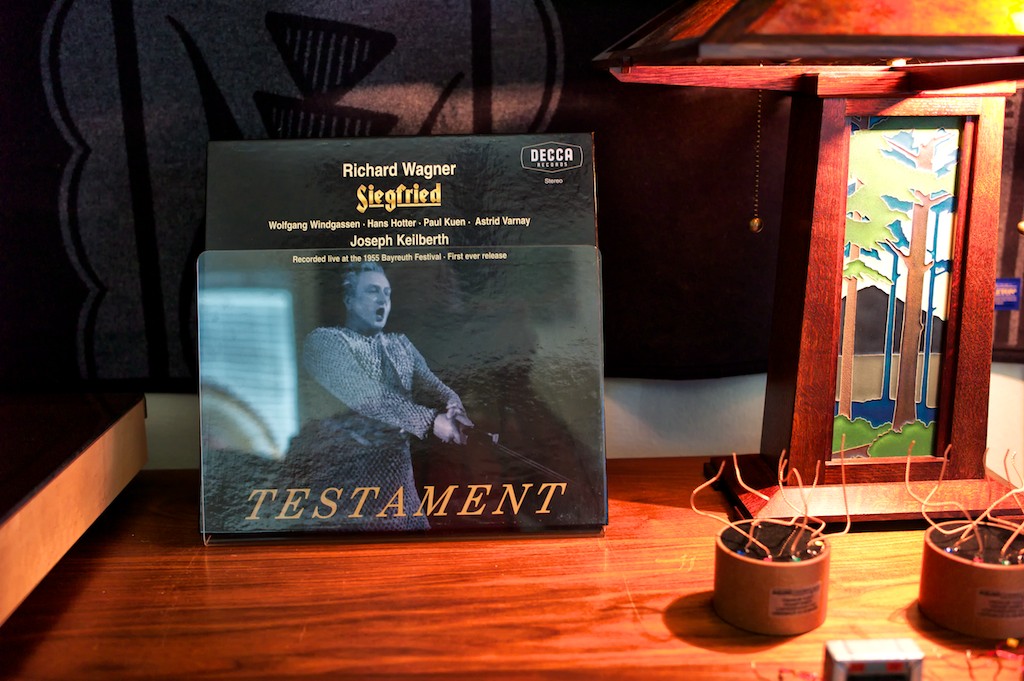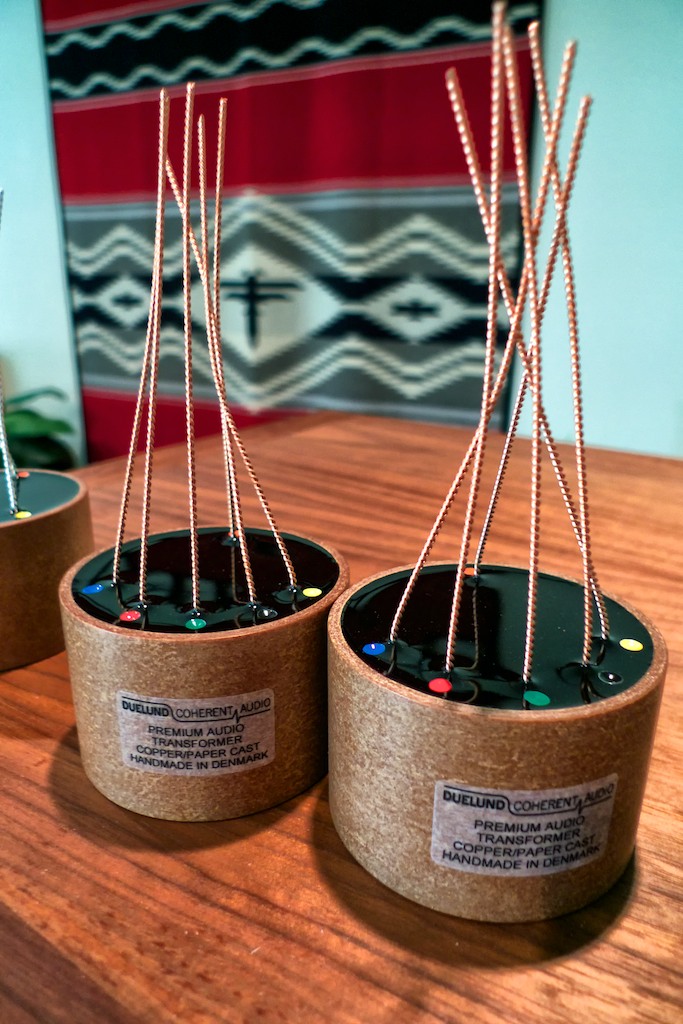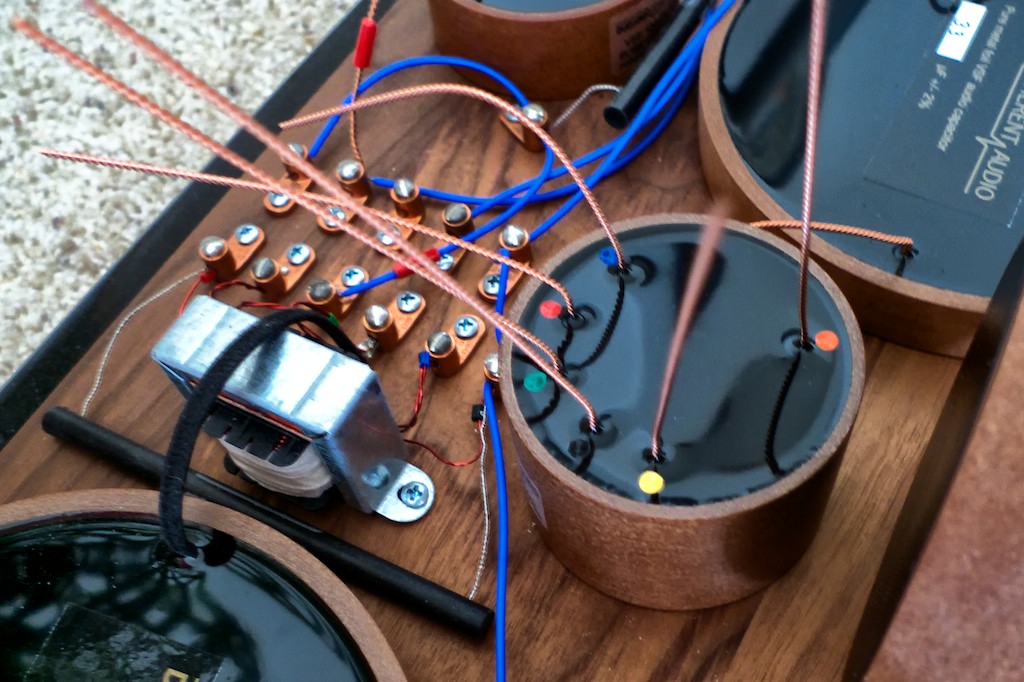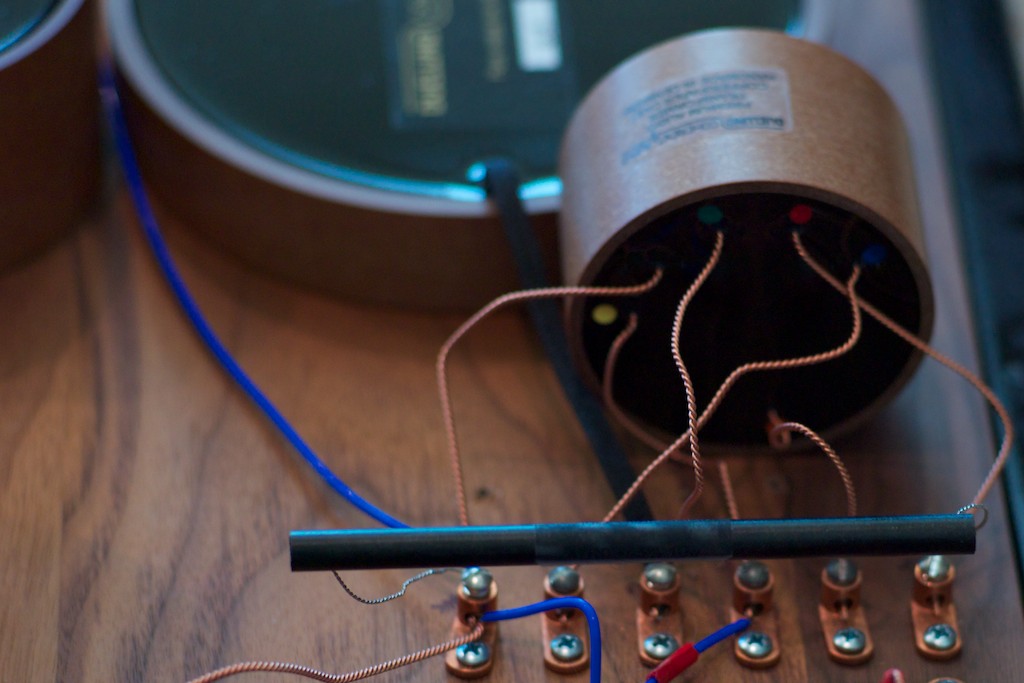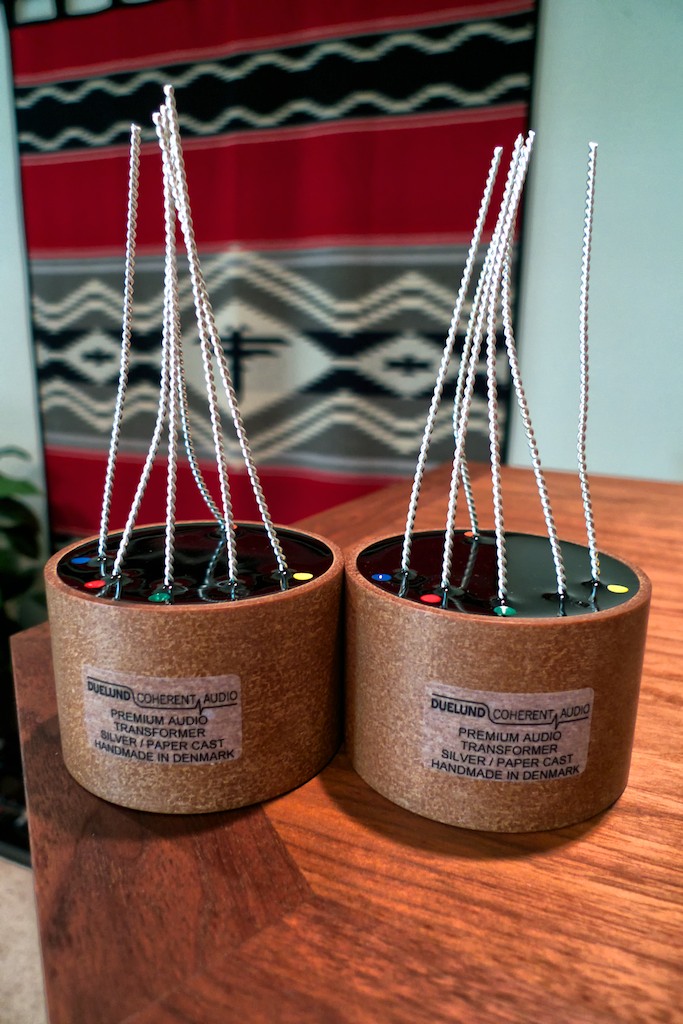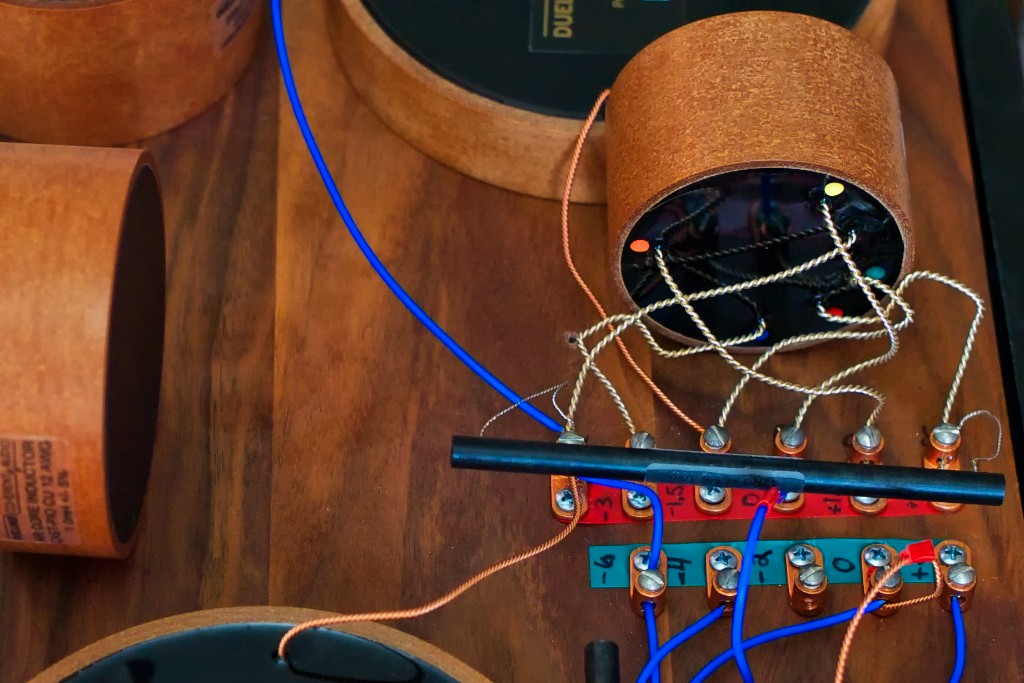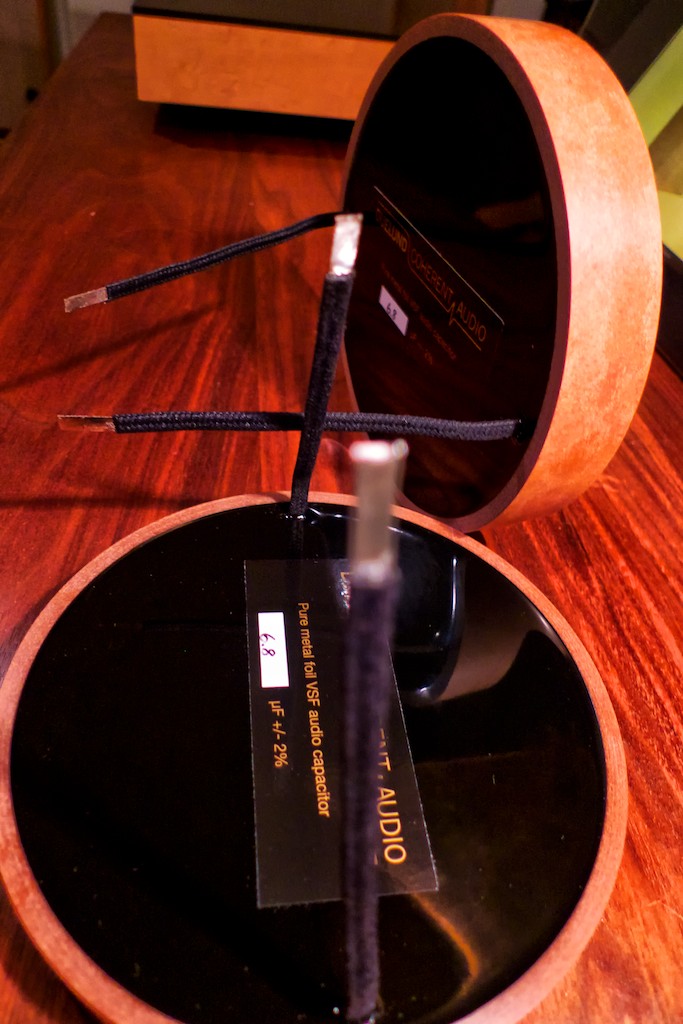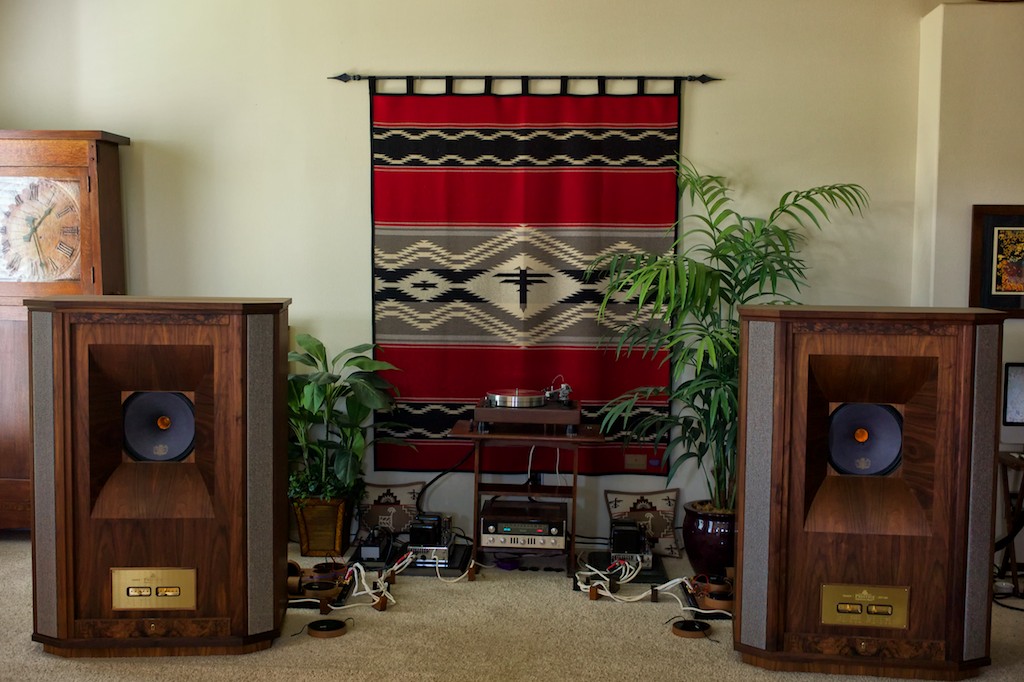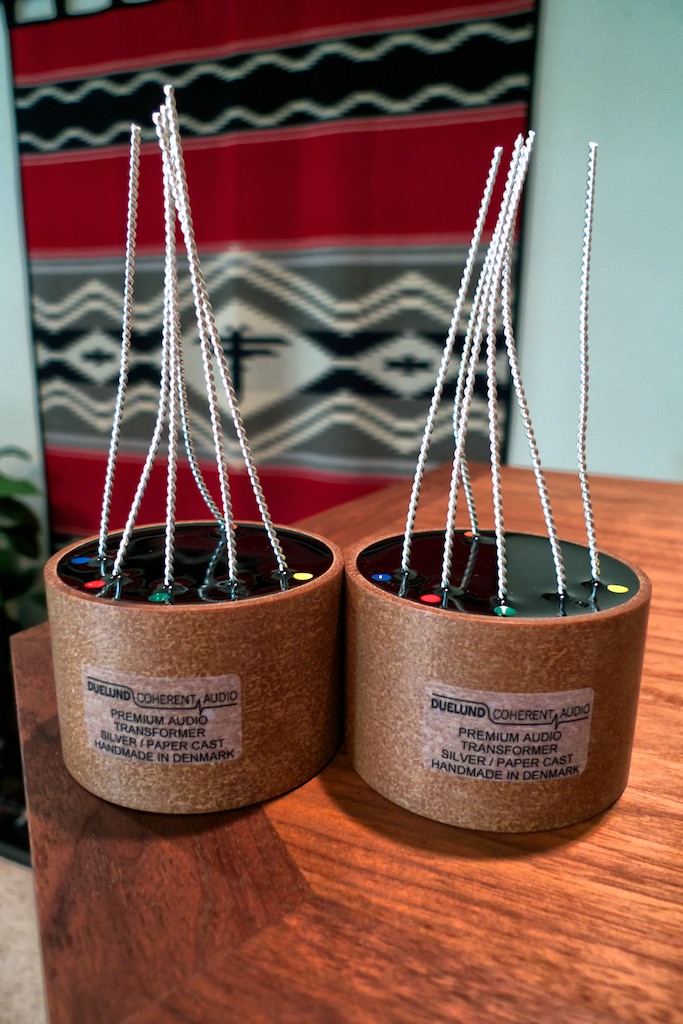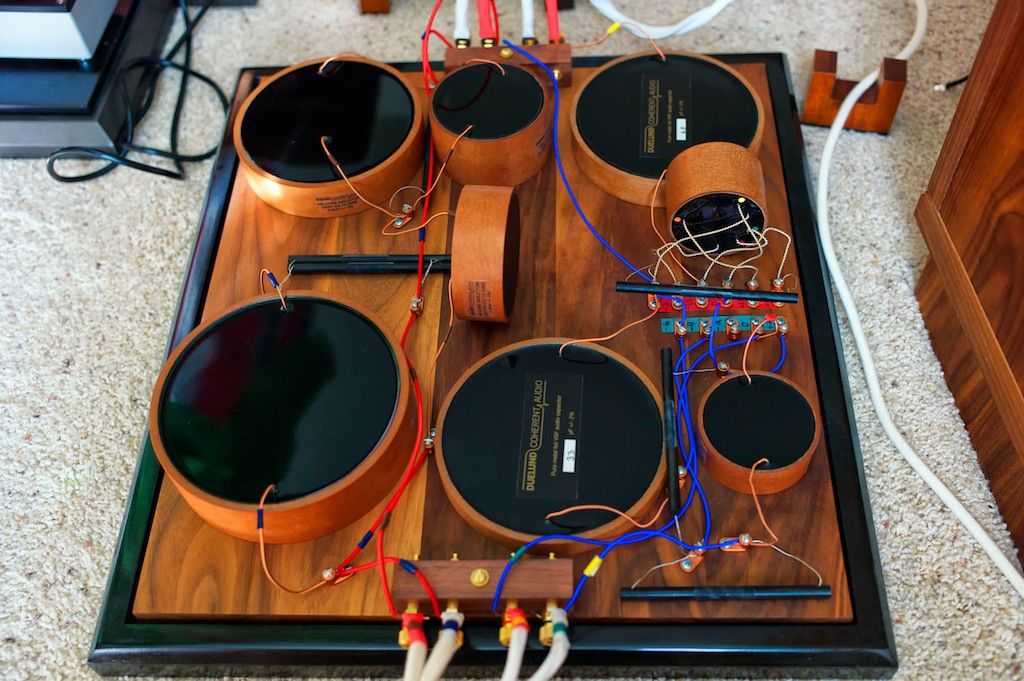Here's my listening impressions for the Duelund CAST Silver Capacitors and Duelund CAST Silver & Copper Autotransformers. I hope you enjoy it!
Listening Impressions
The Stock Westminster Royal SE Loudspeakers
Let me repeat myself a little, with excerpts from the Part 1 article of the Duelund-WRSE Project, to put everything in context for the Part 2 changes to the high-frequency crossover:
“… let’s take a little trip back in time to when I first wrote about the Westminster Royal SEs in Issue 49 of Positive Feedback Online, to get a feel for what a stock pair of Westminsters sound like:
“I get quite a few people asking me what the Westminster Royal SEs sound like, so I'll start with a very general description, and try to elaborate from there. First of all, as you would expect from their size, they sound big. Big in the way music sounds live, and if you closed your eyes for a moment, you could be forgiven for thinking that the music coming through them is coming from musicians playing live, that you're hearing them through a very refined sound system, although I doubt there's many venues where the music sounds as good as when coming through the Westminsters. The Westminster's presentation of recorded music is energizing, life-size, and powerfully moving, much in the same way live music is.
As I've mentioned earlier, the Westminster's overall sonic character is largely determined by the way you've voiced them in your room via your equipment choices. I've chosen associated equipment that makes them sound just a little bit dark and warm overall, with high frequencies that sparkle like starlight through a pitch black night, and with deep, taut, and articulate bass response. The Westminsters voiced thusly have a big, richly colorful tone, and a very natural presentation that is surprisingly agile and transparent, not something I would have expected from a big 15-inch driver.
Perhaps the Westminster Royal SE's most notable attribute is how visceral the musical experience is through them. You can literally feel the sound waves of the music flow over and interact with your body in a way that is uniquely tangible compared to any loudspeaker in my experience. The most vivid example of this is the bass response, which can quite literally rattle your ribs in your chest. But the effect is not limited to bass, it's pretty much that way across the frequency range, where I can feel it energizing my body much in the same way live instruments do, and more than one visitor to my listening room has commented on how involving this phenomena is.
Another aspect of the Westminster's overall presentation, at least when setup like I've described above, is that they can play at very loud levels without my ears shutting down. I'm not sure if it is their very low distortion, the point-source-like delivery of the Dual Concentric™ drivers, or the enormous wave front that washes over you during listening, but I've found that they defeat that 'strained' feeling I normally get as volumes increase, which allows for listening at higher levels than I am used to with other loudspeakers.”
To close the review in Issue 49, I wrote: “As my friend Ron said after hearing the Westminsters, "Where do you go from here!"”
Well, I had never intended to go anywhere else loudspeaker-wise, as I have been thrilled with performance of my stock pair of Tannoy Westminster Royal SEs, but now in response to Ron’s statement, I can say that where you go from a pair of stock Westminsters is to a pair of Duelund CAST external crossovers. The Duelund CAST external crossovers take the already amazing Westminster Royal SE loudspeakers to astonishing new heights! Everything I love about my Westminsters just got better!
My first impressions during the early project phases were “Oh my God – what a difference!” and that is even more true of the completed project. In one word – breathtaking!
All of those attributes I love and have described about the voicing of my stock Tannoy Westminster Royal SEs remained intact, but they have been enhanced to a remarkable degree, and new revelations in performance have presented themselves.
Let me reiterate again how much quieter the background levels of my Westminsters are now with no music playing, due to the Duelund CAST external crossovers. All I can say is that I am floored by the noise level difference between the two crossovers, with the Duelund CAST external crossover being so preternaturally quiet. The reduced noise level that results from Frederik & Magnus’ choice of materials, and the resonance control of the CAST process, works amazingly well – it’s an ear-opener for sure!
The Duelund CAST crossovers provide a massive increase in the sense of recorded space and room ambience …
In virtually every aspect of reproduced sound, the choice of components in crossovers matters a lot more than I had realized, from transparency in the high and low frequencies (all the CAST components), for a sense of space and articulation in the bass region (Frederik was right on when he said the CAST air core inductors make a big difference!), oodles of natural detail (all the CAST components), and an extremely quiet background (all the CAST components).
I was extremely impressed with the astonishingly quiet nature of the Duelund CAST external crossovers compared to my stock internal crossovers, which allowed music full of color and life to emerge from a preternatural background quietness to give a thrilling revelation of musical presence.
The purity of sound through the Duelund CAST crossovers gave me real dividends in terms of musical nuance, low-level dynamics, natural timbral textures, and vivid chordal tonal colors that made the music breathe with life and emotion during listening sessions, and gave me some truly revelatory new insights into my music that I had not been completely aware of before (like the afore mentioned ‘tone color resolution’).
It is truly hard to find the words to fully express what these Duelund components are capable of, in their sonic and musical prowess, and in the emotional power they unleash in the music. I suspect to fully understand what I’m talking about you’re going to want to feel the power of Duelund CAST components for yourself, for they are alive with the glory of music!"
I hope those snippets from Part 1 gave you a feel for the Duelund-WRSE Project progression, from the stock internal crossovers to the ultra-deluxe treatment of Duelund external crossovers, plus the Sablon Audio Panatela internal wiring.
Listening To The Silver & Copper Duelund CAST Autotransformers
I have been listening to the silver & copper Duelund CAST autotransformers, and the 6.8uF silver Duelund CAST capacitors, a lot lately, trying to get adequate time in on them to make sure they’re run-in completely for this review. Truth is, I thought they sounded great straight out of the box, and they have only gotten better over time. Frederik has mentioned that it can take 300 – 500 hours for everything to completely run in, but if you’re like me, you’ll like what you hear straight out of the box, and it only gets better from there.
It was time to put the crossovers back to their Part 1 configuration with the stock Tannoy autotransformers, and the copper 6.8uF Duelund CAST capacitors in the C1 positions, and get some listening time in to re-establish my listening baseline for a comparison between the stock Tannoy autotransformers, the copper Duelund CAST autotransformers, and the silver Duelund CAST autotransformers.
I put my copy of Ellington Indigos on the turntable and let her spin. Indigos has been a long time favorite of mine for the musical magic contained within, and I just never seem to get tired of that incredibly artful music played by the greatest jazz orchestra that was on planet Earth.
Indigos scored four and a half stars in Downbeat in 1958, where Dom Cerulli called it a “dance set” that emphasized shades of colors, with highlights that included Duke’s piano playing owning ‘Solitude’, Paul Gonsalves tenor sax melody magic in ‘Where or When’, and Shorty Baker’s muted trumpet solo in ‘Mood Indigo’.
Indigos is a lot of fun to listen to with the brass, the percussion, the strings, and of course Duke’s magic piano playing, coming through the mix in mesmerizing musical intensity.
You know what? The Duelund CAST crossover with the 6.8uF Duelund CAST copper capacitor in C1 and the stock Tannoy autotransformer absolutely thrills me on Indigos!
In Part 1 I discussed how struck I was by the tone color resolution of the Duelund CAST external crossovers. Many components can blur, homogenize, bleach, or alter tone colors in ways that diminish the emotional connection to the music, but on Indigos the greater ‘tone color’ resolution of the Duelund CAST crossovers allows the tone color of individual instruments in the orchestra to come alive. With the Ellington orchestra I could hear the timbral / tone color contribution of all the individual instruments, which gave the music a higher level of engagement that was more emotionally gripping and exciting. Once I heard it I was addicted.
When Dom Cerulli said Indigos emphasized shades of colors, I knew exactly what he was talking about with the Duelund CAST crossovers: shades of blue notes (Eb, F#, Bb) added into the major and minor triads, but not just blue notes, there’s blue notes that fade into indigo notes, and then into black notes. Ok, I just made up the part about ‘indigo’ & ‘black’ notes, as there’s no such thing, but I wanted to use those terms to make a point, because I don’t know how Ellington’s orchestra makes the tone color shadings sound as amazing as they do. I promise that if you listen to this record through the Duelund CAST crossovers, you’ll feel every shade of blue through indigo, and then feel it fade into a brooding ethereal beautiful blackness in the recording, and you’ll know exactly what those made up terms mean. The resulting emotional intensity was shattering – I almost broke down and cried. Really. It was pretty damn amazing.
While you’re thinking about that revelation of tone colors let me tell you about Duke’s piano playing on ‘Solitude’ – he owns it: delicateness, dissonance, percussiveness, colorfulness, rich textures, and beauty. I found myself hanging on every note with his slow and expressive tempo, the creative dynamic & textural contrasts, that Duke weaves in. It’s a “Wow!”
Now listen to Paul Gonsalves play the melody line on his tenor sax in ‘Where or When’. Paul’s timbrally rich and haunting tone playing the melody line was achingly beautiful, expressive, and mesmerizing, which I suppose is a roundabout way of saying the Duelund CAST crossover was superb at getting the melody line across to the listener, even at slow tempos, with a tenor sax.
Finally, let’s listen Shorty Baker’s muted trumpet solo in ‘Mood Indigo’. I’ll bet you’re afraid Shorty will take your ears off with it. It’s an unfounded fear: Listen to that rich, robust, tone that Shorty is getting. I was so mesmerized by musical charms that I hadn’t focused much on audiophile-style sonics, but just listen to that huge sense of space around Shorty, and the spread of instruments across the width and depth of the soundstage – it was impressive.
The Duelund CAST external crossover with the stock Tannoy autotransformer was stunning both musically and sonically. If the stock Tannoy autotransformer was all that bad it would really throttle down what the Duelund CAST crossover is capable of, but it didn’t, it was pretty damn good in its own right. It is befitting a fine loudspeaker like the Westminster or Canterbury, and Tannoy did an impressive job on their autotransformer. With the stock Tannoy autotransformer in the Duelund CAST circuit, revelation after musical revelation unfolded before my ears. It’s nice!
The Copper Duelund CAST Autotransformers
Now it was time to take the stock Tannoy autotransformer out of the high-frequency crossover circuit and put the copper Duelund CAST autotransformer in the circuit and give it a listen.
In the photo above you can see the stock Tannoy autotransformer and the copper Duelund CAST autotransformer side-by-side.
In the photo below you can see the copper Duelund CAST autotransformer installed into the high-frequency crossover circuit to the right of the 6.uF copper Duelund CAST capacitor in the C1 position.
The first thing I noticed on Indigos when listening to ‘Solitude’ with the copper Duelund CAST autotransformer replacing the stock Tannoy autotransformer was how much louder I could turn up the volume before any sense of strain crept in – I’d say close to 25% more. Having said that, I also found I had to be a little bit judicious with setting the volume because there’s noticeably greater dynamic swings between the softest and loudest sections of the song with the copper Duelund CAST autotransformer in the circuit.
For example, if I turned the volume up that extra 25% on the opening of ‘Solitude’ it would pretty much blow me away as the dynamics got more expressive later in the song, but if I turned it up an extra 10% or so, I reaped all the benefits of extra loudness on the softer sections, and it really was riveting on more dynamic sections without being overbearing. That’s a good thing, and worthwhile both musically & sonically.
The copper Duelund CAST autotransformers were also much more transparent and resolving than the stock Tannoy autotransformers, allowing subtle details to come through that you can’t even hear with the Tannoy autotransformers, like subtle pedal movements on Duke’s piano in ‘Solitude’. Ok, fair enough, that’s not musical information, but I couldn’t hear it at all with the Tannoy autotransformer in the circuit. On the musical side, I noticed more duration in the decay of the musical notes before they trailed off into silence, which I think is musically meaningful.
So how about Paul Gonsalves’ tenor sax melody line on ‘Where or When’? The timbral signature of Paul’s tenor sax sounded more natural and organic with the copper Duelund CAST autotransformer replacing the Tannoy autotransformer in the circuit, but what really struck me was how much more noticeable the other instruments in the mix were, with all kinds of presence in the soundstage from the other instruments, that I hadn’t really noticed or thought about with the stock Tannoy autotransformer in the circuit.
On Shorty Baker’s muted trumpet solo in ‘Mood Indigo’ I thought the tone was richer and smoother with the copper Duelund CAST autotransformers than it was with the Tannoy autotransformers, while at the same time there was a much greater sense of transparency. There was also a much greater sense of space in the soundstage, which really opened up, filling my room with the recording’s ambience.
In general, with the copper Duelund CAST autotransformers, the images are also much more defined and present, making their location on the soundstage much more apparent.
As I was writing about my impressions of the copper Duelund CAST autotransformers, I realized that I was talking more about the audiophile parameters of imaging, soundstage, resolution, and soundspace; rather than the even more important musical attributes like timbral realism & tone color resolution, and the convincing portrayal of melody, harmony, rhythm, dynamics, loudness, and tempo, which make up the fabric of the music itself.
I suppose that’s because there was such a notable difference between the performance of the copper Duelund CAST autotransformers and the stock Tannoy autotransformers on the audiophile parameters of imaging, soundstage, resolution, and soundspace. In my listening sessions it was immediately apparent that the copper Duelund CAST autotransformers are at another level of performance compared to the stock Tannoy autotransformers for audiophile-style sonics.
I was impressed with the overall musicality of the stock Tannoy autotransformers and the way they conveyed the excitement and emotional impact of the music – they’re really good in that regard. However, it was also immediately apparent that the stock Tannoy autotransformers are not quite in the same league musically as the copper Duelund CAST autotransformers, but they were closer musically than they were sonically. The copper Duelund CAST autotransformers, for example, were better in the way they handled loudness & dynamics, and timbre & tone color was more realistic too. I got more of a sense of harmonies with the copper Duelund CAST autotransformers too, mostly because of their greater resolution; so you can hear the different harmonies contributing to the whole easier.
However, even though the copper Duelund CAST autotransformers were dramatically better sonically than the stock Tannoys, and better on the musical attributes that make up the fabric of the music (e.g. timbre, tone color, dynamics, loudness, melody, harmony, et al), it was about a draw between the two when it came to conveying the overall excitement and emotional impact of Indigos. I was quite surprised that they were so close in that regard given the fact the copper Duelund CAST autotransformers were so notably better in sonic and musical terms. So the stock Tannoy autotransformers are actually quite formidable from the standpoint of conveying the visceral excitement and emotional impact of the music, even though the copper Duelund CAST autotransformers are in another league sonically & musically.
Ok, now let’s take a listen to a totally different category of music, something I think that is quite a lot more demanding: Richard Wagner’s Das Rheingold, recorded live at the 1955 Bayreuth Festival, with Joseph Keilberth conducting, on Decca.
Let’s see how well these two very different sets of autotransformers perform sonically, musically, and from the aspect of emotional impact.
I thought the opening swell of music on of the orchestral prelude on Das Rheingold Side 1 was magnificent: the loudness gradually increased over time creating an emotionally riveting effect that was really impressive through the copper Duelund CAST autotransformers. The prelude reminded me of the increasing intensity of light and color in a sunrise, until it is revealed in all its glory – the orchestral prelude was amazingly beautiful!
The strings were to die for, being rich, rosiny, and it was easily audible to discern the violins, violas, cellos, and basses from the other orchestral instruments like the woodwinds, harps, the brass, the timpani, and the percussion. If you like hearing all the intricacies of instruments in the orchestra and the way they weave into the fabric of the music (I do), you’re going to love the way the copper Duelund CAST autotransformer portrays them in all their individual glory and as a whole (I did!).
When the female vocals (Jutta Vulpius, Elisabeth Schartel, and Maria Graf) come in after the orchestral prelude, I was struck by their superb articulation, natural clarity, and powerful dynamics of their voices. The male vocalists were served equally well, and when, for example, Gustav Neidlinger’s vocals came in there is an intensity, presence, and authority that was positively striking!
So yes indeed, on Das Rheingold the copper Duelund CAST autotransformers were very impressive. I also thought it was notable that vocal sibilants were handled as artfully and naturally as I’ve ever heard them portrayed. If, like me, you’ve noticed how overdone vocal sibilants can detract from the music experience, you’ll be impressed with what you hear here: smooth, natural, clear vocal sibilants that actually had a soothing effect! I was impressed; I thought the vocal sibilants sounded as natural and audibly caressing as someone talking with me in life. Very nicely done!
So what did I think of Das Rheingold as played through the stock Tannoy autotransformer? On the orchestral prelude on Side 1 I thought the increasing loudness as the prelude came in and developed was compressed on the stock Tannoy autotransformers compared to the copper Duelund CAST autotransformers. The Duelund started softer, showed off the gradually increasing volume more clearly, and was more emotionally dramatic up to the climax when the female vocalists came in. The Duelund autotransformers were breathtaking; the Tannoy autotransformers were just ok in comparison.
Strings were not handled nearly as well with the Tannoy autotransformers, as they sounded leaner, more ‘wiry’ and harsher, and not nearly as smooth, natural, and rosiny as they did with the copper Duelund CAST autotransformers. A lot of the details of the individual instruments were lost as the sound became more homogenized with the stock Tannoy autotransformers. The extra resolution, imaging, and overall clarity of the copper Duelund CAST autotransformers paid big dividends with the orchestra, making it come alive and bristling with all kinds of meaningful musical detail. The sound was harsher and more homogenized on Das Rheingold with stock Tannoy autotransformers compared to the copper Duelund CAST autotransformers. While I still thought Das Rheingold was amazing music, it was clear that the stock Tannoy autotransformers throttled back my musical enjoyment compared to the copper Duelund CAST autotransformers.
Also dynamics were not nearly as graduated, smooth, and emotive with the stock Tannoy autotransformers, and they would get shouty in places that the copper Duelund CAST autotransformers sailed through easily, cleanly, and musically. I actually had to get up with the stock Tannoy autotransformers and turn down the volume from what I was comfortable with from the copper Duelund CAST autotransformers, which diminished the overall excitement and emotional connection to the music.
With the stock Tannoy autotransformers, vocals could become sibilant in an unpleasant way, and harsh on dynamic peaks. Turning down the volume helps, but still I thought the copper Duelund CAST autotransformers were clearly in another league when comparing the reproduction of vocals.
As music got more complex and demanding, as it does in Das Rheingold compared to Indigos, the superior performance of the copper Duelund CAST autotransformers became much more obvious to me. On Das Rheingold the copper Duelund CAST transformers were at another level compared to the stock Tannoy autotransformers in every meaningful way: sonically, musically, and in the way the music emotionally connected with me.
Ok, let’s shift gears again and try another musical category with the Legacy reissue of Paul Simon’s Still Crazy After All These Years. This reissue on 180 gram vinyl by Columbia/Sony Legacy was recommend by Michael Fremer on his blog, saying, “The original was a good sounding record mastered at Sterling Sound (but not attributed to anyone) but this reissue absolutely kills it in every way.” I’ve always enjoyed the music, so Michael’s recommendation was enough for me, and I picked up a copy.
With the stock Tannoy autotransformers Still Crazy was musically engaging, and I enjoyed the music, the big ambient soundspace of the recording filled my room, and the rich velvety presentation of the music was a treat to the ears. Still Crazy is fun ‘feel good’ rock-pop music, and that vibe comes through convincingly. I had fun listening to Still Crazy and I think you would have too.
The tempos, beat, and melody lines got my feet tapping, and I thought the stock Tannoy autotransformers represented them well on Still Crazy, in a completely natural and realistic way, serving the music well. Harmonies sounded really nice, very musical, and I think, very like they do in life.
As with Das Rheingold, I noticed some sonic warts using the stock Tannoy autotransformers: occasionally vocal sibilants sounded a little bit nasty, and dynamic peaks sounded a bit harsh.
Imaging was quite good with the stock Tannoy autotransformers on Still Crazy, and there was a nice spread of instruments across the soundstage, and somewhat into its depth with noticeable layering, but overall depth was nothing to write home about, and it got a bit opaque the further back into the stage I listened.
With the copper Duelund CAST autotransformers installed into the crossovers in place of the stock Tannoy autotransformers, the ambient soundspace of Still Crazy got even bigger, and the instruments’ images were more prominent on the soundstage, and the layering was more distinct. The images also projected forward from the speakers more, and back deeper into the soundstage, giving much more of an expansive feel to the soundstage. Imaging could be as far as six feet outside of the left and right of the loudspeakers, making for a wide and exciting soundstage presentation.
The timbral textures were more distinct, and the tonal colors were more deeply saturated, with the copper Duelund CAST autotransformers, which gave the music a lusher, richer, more emotive feel on Still Crazy.
Interestingly, the copper Duelund CAST autotransformers are warmer and more natural sounding, while at the same time being much more transparent than the stock Tannoy autotransformers. This allowed musically significant detail to come through, creating a more compelling musical experience, without any of the ‘in your face’ feeling you normally get with a lot of detail being present. I could hear quite a lot more of interesting inner details and harmonies that were completely missing with the stock Tannoy autotransformers, and it made the music sound … well … more like music!
I also felt that the beat was more propulsive feeling with the copper Duelund CAST autotransformers, and I got more of a sense of tempo’s speed, which really helps bring rock music alive, and like all good rock & roll, everything got better musically when turning up the volume on Still Crazy, with the room becoming awash with musical textures and the kind of excitement that live music is loaded with naturally.
When I listen to Still Crazy I can’t help but be transported back to 1975 and all the fun memories it conjures up. Both of these pairs of autotransformers bring the music alive, but the copper Duelund CAST autotransformers bring it more alive with better sonics, better musicality, and with a stronger emotional connection to the music.
The Silver Duelund CAST Autotransformers
I slipped the silver Duelund CAST autotransformers into the high-frequency crossovers in place of the copper Duelund CAST autotransformers for a little comparison on Still Crazy. The design of the crossover with its setscrew lugs makes the installation a relative breeze – thanks, Pete Riggle, for the idea!
The first thing I thought of when Still Crazy started playing on my VPI Classic turntable was “the silver Duelund is like the copper squared.” The improvement was so dramatic I couldn’t help but be taken aback by it. Yes, the silver Duelund CAST autotransformers are really good, and they’re good across the board too: sonically, musically, and from an emotional engagement standpoint. They don’t miss a single performance element – overachievers for sure!
Let’s take the emotional connection aspect of the silver Duelund CAST autotransformers first, because that’s the aspect that really turned my head when I started listening to Still Crazy. In comparison to the Tannoy or copper Duelund CAST autotransformers, the silver Duelund CAST autotransformers were shockingly better at creating an emotional connection, and when I heard the difference I got … well … all emotional. No kidding, the inclusion of the silver Duelund CAST autotransformers had a remarkable emotional effect on me, and my emotional connection to the music went off the charts, nearly bringing me to bewildered tears at the result.
Let’s put that in perspective: when I do comparative listening sessions for a review it can be very tedious. I listen to the same music over and over as I switch components in and out, which I do so I can give you accurate & detailed descriptions of what I’m hearing that I think you’ll be able to relate to, and why I think it is important (or not). Normally listening fatigue sets in after doing comparative listening for a while, and the emotional connection becomes less and less as I listen to the same piece of music multiple times, while I slowly transition into a more analytical mode of listening in the process. So when I think my listening fatigue is getting out of hand, I take a break for a while, because I want to make sure I’m giving all the components a fair shake in every way that I like to characterize them (e.g. sonically, musically, and from an emotional impact standpoint).
Yet just when I was thinking I really needed to take a break to recoup, I put the silver Duelund CAST autotransformers into the high-frequency crossovers and it completely blew me away emotionally! The music just came alive and grabbed me by the heart. I was so riveted by what I was hearing: the meaning of the vocals transfixed me, the beauty of the instruments astonished me, and I felt a sort of musical rapture that carried me along on a wave of music in the very sort of way that all of us as music lovers yearn for. Instead of feeling listening fatigue I felt immediately refreshed and invigorated! Yes, the silver Duelund CAST autotransformers are in a class by themselves when it comes to an emotional connection. Neither the stock Tannoy autotransformers nor copper Duelund CAST autotransformers came close to this aspect of the silver Duelund CAST autotransformers’ abilities. I think this aspect alone makes them well worth their extra cost over the copper versions.
Those of you who have been following my scribbling’s for a while know how much it bugs me when us reviewer types only talk about performance related to recording artifacts like imaging, soundstage, soundspace, and other audiophile sonic parameters, while ignoring the discussion of performance on important musical attributes like timbral realism & tone color resolution, and the convincing portrayal of melody, harmony, rhythm, dynamics, loudness, and tempo, which make up the fabric of the music itself.
The good news is that the silver Duelund CAST autotransformers are shockingly good on both the audiophile-style sonic parameters and the all important musical attributes!
Here’s something I haven’t quite figured out during my listening sessions: You know how when you think of silver components, you normally think of it as being brighter and more detailed than copper in its sonic signature? In a surprising twist of audio reality the silver Duelund CAST autotransformers are warmer, richer, and more colorful & natural sounding than its copper brethren when substituted into the high-frequency crossover, yet still recovered considerably more detail, and threw a much larger sense of recorded ambience into the listening room. It does everything else better too – a lot better, and the copper Duelund CAST autotransformer is damn good!
So essentially the silver Duelund CAST autotransformers are in that category of components that leaves you scratching your head wondering how all that is possible in one package, yet it is.
The silver Duelund CAST autotransformers offer a timbral realism that was unparalled among these three sets of autotransformers. Every instrument on Still Crazy sounded so timbrally real and present on the soundstage it was astonishing. Electric guitars, drums, percussion, piano, and horns continually impressed me with how close they came to sounding like the timbre of real live instruments in my living room.
Chordal tone color resolution was fantastic with the silver Duelund CAST autotransformers, and that adeptness at tone color really added extra expressiveness to the music on Still Crazy.
The silver Duelund CAST autotransformers were also an eye opener in the way they portrayed melody, harmony, rhythm, and tempo, and they are just at another level of performance compared to the other two sets of autotransformers here. Melodies were vibrant with foot-tapping touch & excitement on Still Crazy, with tempos – fast or slow – informing the mood of the songs’ lyrics in a way that made each one full of emotion and feeling.
The silver Duelund CAST autotransformers added additional musical prowess to that of the copper Duelund CAST autotransformers, in terms of dynamics and loudness, where they easily played the scale of soft to loud effortlessly, while sounding so clean & natural, and they tracked loud dynamic peaks with ease, without ever even sounding slightly stressed in doing it. Really superb!
The silver Duelund CAST autotransformers blew me completely away with their sonic prowess in the realms of soundstaging, soundspace, and imaging, and I really loved what they were capable of! I heard huge soundstages with a sense of space that completely filled my room on Still Crazy, with images that popped holographically out of the stage as they came in and out of the music. The images had a sense of space all around them of the sort that SET aficionados drool over, and never, ever, did it sound etched, contrived, or artificial, rather it was a natural, flesh & blood presentation of images in a living and breathing soundspace that totally impressed me.
When sonics are done spectacularly right – they rarely are – in combination with superb musicality and a high level of emotive impact, it is a true treat for the ears, and is as fun as all get out! With the silver Duelund CAST autotransformers in the high-frequency circuit of my Duelund-WRSE external crossovers I’ve never heard it done so right, and it has been a truly awe-inspiring experience for me to hear!
Remember how I said that as the musical performance became more complex and demanding of the equipment, like with Wagner’s Das Rheingold, the copper Duelund CAST autotransformers really came into their own over the stock Tannoy autotransformers?
I thought it was time to challenge the silver Duelund CAST autotransformers in the same sort of way, so I got out my Testament reissue of the superb Decca box set of Richard Wagner’s Die Walkure, recorded live at the 1955 Bayreuth Festival, with Joseph Keilberth conducting.
Would the silver Duelund CAST autotransformers that blew my mind on Paul Simon’s rock album Still Crazy After All These Years be able to pull off the same magic trick on something as challenging as Die Walkure?
The answer is yes. The more demanding the music – in this case Die Walkure – the more obvious it was how really good the silver Duelund CAST autotransformers were sonically, musically, and emotively. They are flat out amazing.
Ok, so I’ll save you the blow-by-blow analysis of the silver Duelund CAST autotransformers in every sonic, musical, and emotive category, across a bunch of different records with varying musical styles, but let me say this: the silver Duelund CAST autotransformers are amazing in my Duelund-WRSE external crossovers. If you’re thinking about buying a pair of the Duelund CAST autotransformers to put in the high-frequency circuit of your custom Duelund crossovers for your Tannoys, the silver Duelund CAST autotransformers are worth every penny more that they cost over the copper versions.
Summarizing & Rating Autotransformer Performance
Let me summarize what I’ve found out about in listening sessions with these three sets of autotransformers installed into my Duelund-WRSE outboard high-frequency crossovers.
To help you understand what I’m hearing, I’ll break my summary down into the categories of 1) emotional engagement, 2) musical attributes (the fabric of the music itself, like melody, beat, rhythm, harmonies, loudness, dynamics, timbral realism, tone color resolution, etc.), and audiophile-style sonic attributes (recording artifacts like imaging, soundstage, soundspace, resolution, transparency, etc.).
I’ll even attempt to rate them in these categories in a ten star approach, with one star being not so good, and ten stars being stunning.
The stock Tannoy autotransformers: If I had never heard the Duelund CAST autotransformers I’d think the stock Tannoy autotransformers were pretty wonderful. On simpler music in particular, they’re very emotionally engaging, and they do particularly well on getting the melody, rhythm, beat, and tempos of the music across to the listener, and overall I really enjoyed listening to music through them.
As music gets more complex and demanding, like with the Testament reissues of the Decca live recordings at the 1955 Bayreuth Festival, with Joseph Keilberth conducting, the performance limitations of the stock Tannoy autotransformers becomes more noticeable. Timbre of the strings sounded more wiry and leaner than they do in life, for example, and there was some unpleasant vocal sibilance that could be distracting at times. Tone color was also a little homogenized & bleached, which tended to make the music a little less interesting and emotionally engaging.
Dynamic range – that difference between the quietest and loudest volumes – sounds compressed on the stock Tannoy autotransformers compared to the Duelund autotransformers, with the softest end of the dynamic shadings missing, and the small increments of increases in loudness scaling up to a crescendo are smoothed over, both of which serve to make the music feel less live, and less exciting.
The stock Tannoy autotransformer also tends to lose its composure at loud levels on dynamic peaks by getting harsh, which left me wanting to reach for the volume control of my McIntosh MX110Z to turn things down.
Resolution is not what it could be through the stock Tannoy autotransformers either, making orchestral strings sound homogenized and congested in comparison to the Duelund autotransformers. Small details that are completely audible in a meaningful sort of way with the Duelund autotransformers in the circuit can go completely missing through the Tannoy autotransformers.
From an emotional engagement standpoint I thought the stock Tannoy autotransformers were really good, so I rated them at five out of ten stars. The stock Tannoy autotransformers perform respectably with respect to musical engagement with melodies, beat, and tempos, but fall down on the job in the areas of natural timbre, tone color resolution, dynamics, and loudness, so I rated them three out of ten stars for musical attributes. The stock Tannoy autotransformers are only average in resolution, transparency, and imaging, so I rated them at three out of five stars for sonic attributes.
Emotional engagement (5 ★): ★★★★★
Musical attributes (3 ★): ★★★
Sonic attributes (3 ★): ★★★
The copper Duelund CAST autotransformers: The copper Duelund autotransformers really upset the apple cart when I put them in the high-frequency circuit of my Duelund-WRSE outboard crossovers, because they really laid bare the limitations of my stock Tannoy autotransformers, and there was no going back after that.
What was immediately obvious in my listening sessions was how good sonically the copper Duelund CAST autotransformers were compared to the stock Tannoy autotransformers, particularly as the music got more complex and demanding, as with classical music.
The copper Duelund CAST autotransformers extra resolution and transparency really improved the presentation of classical music, by allowing the individual contributions of the violins, violas, cellos, and basses to be easily discernible, as well as the woodwinds, harps, the brass, the timpani, and the percussion. The copper Duelund CAST autotransformers allowed all of the individual instrument contributions to the orchestral performance to come through in an easily discernible, natural, and very musical way that I found to be really enjoyable. In comparison, the stock Tannoy autotransformers homogenized the contributions of the individual instruments of the orchestra, making the music less interesting and less beautiful.
The timbre of instruments also improved markedly with the copper Duelund CAST autotransformers, with strings, for example, becoming ravishingly beautiful by being rich, rosiny, and natural, whereas with the stock Tannoy autotransformers they sounded lean and wiry in comparison. For classical music lovers the timbral realism that the copper Duelund CAST autotransformers bring to the music is huge in musical dividends.
The copper Duelund CAST autotransformers removed most of the compression of the dynamic range I was hearing with the stock Tannoy autotransformers, with the softer end of the dynamic scale making an appearance, which was completely lost with the stock Tannoys. On the big dynamic swings when the music got loud, the copper Duelund CAST transformers almost always tracked it with ease, allowing me to enjoy the music at natural live-music volume levels without my ears shutting down and making me want to reach for the volume control like they did with the stock Tannoy autotransformers.
Tone color resolution really improved with the copper Duelund CAST autotransformers compared to the stock Tannoy autotransformers, which gave a nice increase in intelligibility of the chordal tone color choices used by musicians in different musical styles, which helped me understand the artistic choices the musicians made in composing and playing their music. For example, it became easier to distinguish what musicians were doing with alterations to three-note triads by adding additional pitches, as with the major & minor 6ths, major & minor 7ths, dominant 7ths with flat or sharp fives or nines, major & minor & dominant 9ths, 11th, augmented 11th, 13th, etc., that give life and meaning to the different styles of music, which are stylistically defined by groupings of tone colors to create their ‘musical feel’ for that particular style of music, which helps musicians craft a certain musical message and emotive feel to go with the music.
After listening to the copper Duelund CAST autotransformers, it was apparent that the stock Tannoy autotransformers blurred, homogenized, bleached, and altered tone colors far more than I had realized. This revelation in tone color resolution is one of the great strengths of all the Duelund components I have had experience with, including the Duelund CAST autotransformers, and this superior presentation of the tone color aspects of the musical fabric is a really big deal for the intended musical message fully getting from the artist to you, the listener.
I already noted that the copper Duelund CAST autotransformers perform significantly better in terms of resolution & transparency compared to the stock Tannoy autotransformers, but they are also significantly better at reproducing recording artifacts like imaging, soundstage, and a sense of soundspace as well. Imaging really improves with the copper Duelund CAST autotransformers, probably as a result of the combination of the increased resolution and transparency they offer. The sense of space in the recording increases dramatically with the copper Duelund CAST autotransformers over the stock Tannoy autotransformers, as does the soundstage, which becomes more expansive in width and depth.
From an emotional engagement standpoint, I only rated the copper Duelund CAST autotransformers one star more than the stock Tannoy autotransformers, at six stars, which I think deserves some additional explanation.
First of all, the stock Tannoy autotransformers are damn good at creating a sense of emotional engagement to the music. With the stock Tannoy autotransformer I found myself laughing, crying, dancing around the room, strutting around like Mick Jagger, or trying to do an occasional moonwalk, to the music – they’re really good from an emotional engagement standpoint.
When it came to engaging melodies, beat, and tempos, the Tannoy is very nearly the match of the copper Duelund CAST autotransformer. Where the copper Duelund CAST autotransformers quickly excelled beyond the stock Tannoy autotransformers in emotional engagement was with classical music, where it pretty much left the Tannoy autotransformers in the dust.
I gave the copper Duelund CAST autotransformers five stars to the Tannoy autotransformers’ three stars, for their superior level of performance in portraying natural & realistic timbre, high levels of tone color resolution, superb rendering of dynamics, and the ability to play loud dynamic peaks without strain. In comparison to the copper Duelund CAST autotransformers, the Tannoy autotransformers had bleached and lean timbre, homogenized tone color resolution, compressed dynamics, and could get shouty if played louder than they were comfortable with.
Sonically the copper Duelund CAST autotransformers are at another level compared to the stock Tannoy autotransformers too, with dramatically better transparency, resolution, imaging, soundstaging (particularly depth), and the ability to convey a larger sense of recorded space that the Tannoy autotransformers can only dream about, and for that I award the Duelunds five stars compared to the Tannoy’s three stars.
Emotional engagement (6 ★): ★★★★★★
Musical attributes (5 ★): ★★★★★
Sonic attributes (5 ★): ★★★★★
The silver Duelund CAST autotransformers: The silver Duelund CAST autotransformers were an ear-opener, and they significantly improved upon all the strengths that I heard in the copper Duelund CAST autotransformers.
The silver Duelund CAST autotransformers were at least as much better, sonically, than the copper Duelund CAST autotransformers were better than the stock Tannoy autotransformers. I’m not talking barely discernible subtleties here, I’m talking big differences: twice as good, five times as good, an order of magnitude better, that sort of range of improvement is what I’m talking about.
For example, the silver Duelund CAST autotransformers had significantly more resolution and transparency than the copper Duelund CAST autotransformers (which are impressive in their own right), which I thought really brought the presentation of classical music alive with all kinds of interesting musical details as I could hear all the strings, woodwinds, harps, the brass, the timpani, and percussion in their individual glory.
Another sonic treat was how much more the recording opened up, with a dramatically larger sense of living & breathing space in the soundstage, than with the copper Duelund CAST autotransformers. Then there’s the presence of images on the soundstage, which had a remarkable level of tangible presence, and with a very audible cushion of space & air around the instruments that pulsated with energy from the first strike of a note, to its long harmonic decay into blackness. The images all sounded so natural, so enchanting, and so colorful, that they were absolutely mesmerizing to listen to. This was the sort of imaging performance that single ended triode (SET) fans would be willing to die for if their amps could only do that magic trick as well as these silver Duelund CAST autotransformers can.
Then there’s the increased dimensions of the soundstage itself, where the right and left of the stage extended a lot further out with the silver Duelund CAST autotransformers than the copper Duelund CAST autotransformers. Remarkably, the soundstage also extended rather dramatically further forward in front of the speakers, and presented some images quite a few feet in front of the loudspeakers when listening to the new Speakers Corner reissue of Louis Armstrong’s and Ella Fitzgerald’s performance of George Gershwin’s Porgy & Bess on Verve. How much better are the silver Duelund CAST autotransformers than their copper sisters in presentation of soundspace, soundstage, and imaging? Two times better? Five times better? Ten times better? I’d say its closer to ten times better than two times better.
One thing I have noticed about the silver Duelund CAST components compared to their copper stablemates – as I mentioned earlier – is how they sounded smoother, more detailed & transparent, and more natural, all at the same time. The first time I encountered this phenomena with silver components was with Mark Coles’ Sablon Audio Panatela interconnects and speaker cables, and it surprised me. Up until the Panatela all of the silver components I had heard sounded more detailed & transparent, but with the down side of being brighter, etched sounding, compromising timbre somewhat, and generally sounding a little unnatural.
Now all of a sudden, I’m again hearing silver done right with the silver Duelund CAST components. It was quite a revelation to hear the powerful advantages of silver come through in such a thoroughly natural and musical way. When silver is done right, as it is here in the silver Duelund CAST autotransformers, it is remarkably good in every single aspect of audio reproduction: emotional engagement, sonic attributes, and musical attributes.
I also thought that the instruments had a significantly better sense of timbral realism with the silver Duelund CAST autotransformers compared to the copper Duelund CAST autotransformers. I wouldn’t have thought that would be possible after listening to how good the copper Duelund CAST autotransformers were in that regard, because they were so much better than the stock Tannoy autotransformers, but one listen to the silver Duelund CAST autotransformers dashed that idea.
For example, when I listened to pretty much any recorded cymbals with the copper Duelund CAST autotransformers, I thought they sounded great. Then when I started listening sessions with the silver Duelund CAST autotransformers I was astonished at how much better – more timbrally realistic – the cymbals sounded. They radiated a shimmering, delicate presence that was like a breathy kiss on my ears, so full of presence, so shimmering real, so utterly natural, so audibly enticing! Whether cymbals, strings, guitars, horns, or whatever, they all were strikingly believable from a timbral realism perspective.
Well ok, the silver Duelund CAST autotransformers sounded fantastic on classical and jazz, but can they handle serious grunge rock? When I put on the Nirvana Live at Reading LP, which was described as one of the ‘100 Gigs That Shook The World’ and ‘Nirvana’s No. 1 Greatest Moment’ on the Acoustic Sounds website, this never before available live recording sounded raw with a full serving of exploding energy, and yet captured the essence of a Nirvana concert wonderfully well. Kurt Cobain’s tortured vocals and strafing guitar licks, Krist Novoselic’s bass coming through like a howitzer, and Dave Grohl’s drums producing a pounding beat gets the message across clearly – this is the greatest live grunge rock performance ever recorded! Guess what? When you can occasionally hear them, Grohl’s cymbals are sublime!
The silver Duelund CAST autotransformers unraveled Live at Reading wonderfully well, with great vocal articulation, and a bit of finely rendered screaming too. Guess what? The last little bit of compression I was hearing on dynamic peaks with the copper Duelund CAST autotransformers was completely absent with silver Duelund CAST autotransformers. I turned up the volume on Live at Reading to rock concert levels and it sounded fantastic, with the big Westminsters pumping out bass notes like they were shotgun blasts, and my ears never once felt like they wanted to shut down, or that I needed to run for cover.
On Live at Reading the silver Duelund CAST autotransformers rendered the heart-attack beat, melody, and tempo fantastically well, giving the full headlong manic rush experience of grunge rock music. Screw timbre on this album, Cobain’s rough & dirty saw-blade riffs on his Stratocaster came through breathtakingly live and raw, until it gave up the ghost and went out-of-tune as he played the hell out of it on stage (yep, that’s damn good tone color resolution!). Grohl’s drum playing was powerful and moving. The silver Duelund CAST autotransformers definitely can play grunge rock with rock ‘em sock ‘em emotional intensity coming through in spades! I was practically breathless and panting after Live at Reading.
Putting on the superb Analogue Productions reissue of RCA Living Stereo LSC 2367, Gershwin’s Rhapsody In Blue and An American in Paris, with Fiedler conducting the Boston Pops, only furthered my already good impressions of the silver Duelund CAST autotransformer’s astonishing musical prowess. Tone color resolution is even better than that of the already impressive copper Duelund CAST autotransformers, infusing life and meaning into the music. I don’t think I can say enough about this aspect of the silver Duelund CAST autotransformers’ performance, as this superior presentation of tone color enriches the musical fabric in truly meaningful ways, and I encourage you as a listener to ‘listen-in’ and start paying more attention to this aspect of music reproduction, it is really a big deal.
From an emotional engagement standpoint, I rated the silver Duelund CAST autotransformers at ten stars, which is the maximum for my little rating system for this article. That’s four more stars for the silver Duelund CAST autotransformers than the already impressive copper Duelund CAST autotransformers’ six stars, and it was well deserved. I was never less than astonished at how much emotional intensity the silver Duelund CAST autotransformers were able to convey from the music. When it came to engaging melodies, beat, and tempos, the silver Duelund CAST autotransformers are king, and they’re quite a bit better than the copper Duelund CAST autotransformers.
I gave the silver Duelund CAST autotransformers ten stars to the copper Duelund CAST autotransformers’ five stars for musical attributes, for they were quite a bit better in the way the portrayed timbre, tone color resolution, dynamics, and their ability to play loud with ease was impressive.
Sonically I rated the silver Duelund CAST autotransformers at ten stars, as they are at yet another level of performance compared to the copper Duelund CAST autotransformers, with notably better transparency, resolution, imaging, soundstaging, and the ability to convey a vast sense of recorded space that the copper Duelund CAST autotransformers could not match.
Emotional engagement (10 ★): ★★★★★★★★★★
Musical attributes (10 ★): ★★★★★★★★★
Sonic attributes (10 ★): ★★★★★★★★★★
The Silver 6.8 uF Duelund CAST Capacitors
It’s hard not to be wowed by the silver 6.8uF Duelund CAST capacitors when you consider what goes into their handcrafted creation, and of course, their breathtaking price. One friend even commented to me that he couldn’t listen to them objectively because he just couldn’t get by their price – they’re frighteningly expensive at €7500 each!
Let’s talk about what the silver Duelund CAST capacitors are: custom made, labor intensive, high cost of materials, assaults on the state-of-art. Performance is the ultimate goal, and the end cost was not a consideration to that end. The silver Duelund CAST capacitors in spirit are akin to the 3-million euro each Lamborghini Venenos automobile, demonstrating what can be done when cost is not a factor, and it is only performance that is a consideration.
If Lamborghini asked me to write an article about the Venenos, I would be terribly excited about telling you all about what its like to experience this unobtainable exotic automobile, in spite of the fact that few of you could afford it, and that I certainly could not. It’s very cool to even dream at that level for yours truly, and I’d be thrilled to tell you about it.
For me, like the Venenos, the silver Duelund CAST capacitors are the stuff that dreams are made of, and I’m thrilled to be able to experience them and tell you all about them, realizing that this is as close as most of you will ever get to them. If you can afford them, they are worth it, just buy them, I cannot imagine you being sorry. For the rest of us, read on, and find out what its like to experience the most expensive pair of 6.8uF silver capacitors on Planet Earth. It’s a rush!
I replaced the 6.8uF copper Duelund CAST capacitors in the C1 position of the high frequency crossovers with the 6.8uF silver Duelund CAST capacitors (photo above). While I did listen to the silver Duelund CAST capacitors during the run-in period with all three sets of autotransformers, I’m only going to discuss how they sound with the silver Duelund CAST autotransformers, because anyone who can afford these silver Duelund CAST capacitors would be crazy to pair them with anything else!
When I first put the 6.8uF silver Duelund CAST capacitors into the high-frequency crossovers of my Westminsters, here’s what I reported to the readers of my Jeff’s Place blog:
“After getting the silvers installed into the crossovers, I settled back to do a little listening. I was trying to temper my expectations because the silvers were cold out of the box, and not run-in or conditioned at all, and I knew they would only get better over time, so I was ready to cut them some slack if they sounded like ‘new’ capacitors.
The result of replacing just the pair of copper 6.8uF Duelund CAST capacitors in my crossovers with the pair of silver 6.8uF Duelund CAST capacitors … and you’ll probably be as crushed by hearing this as I was experiencing it … blew my farking mind – they are beyond awesome! Sorry about having to tell you that, because if you’re an average bloke like me, you probably can’t afford them, and man-oh-man, they are stunningly good,, and you’ll sure wish you could afford them!
Placing silver 6.8uF Duelund CAST capacitors into the C1 positions had a surprisingly dramatic effect, which when you think about it is pretty amazing, considering the already lofty performance level of the copper 6.8uF Duelund CAST capacitors that I use in the C1 position.
Here’s what I didn’t hear: any traces of grain, grit, brightness, harshness, etching, or other nastiness. It was immediately apparent that the Tannoy Dual Concentric high-frequency drivers loved the silvers! In fact the silver 6.8uF CAST capacitors were smooth, rich, natural, detailed, shockingly transparent, and incredibly musical. I thought that set of attributes was particularly remarkable straight out of the box, and I can only wonder what heights the silvers might scale to with a little more time on them.
My friend Leo stopped by for a visit right after I put the silvers in the crossovers. Leo commented that putting in the silvers was like removing a veil that was in front of the loudspeakers, with much more detail coming through, and with many more instrumental layers being evident. Leo was right on! … Frederick, I am absolutely in awe of what you have done with the silver 6.8uF Duelund CAST capacitors!”
In an enthusiastic post, a few weeks later on Christmas Day, I said:
“The Silver Duelund CAST 6.8uF paper-in-oil capacitors are simply amazing! Who would have thought that two capacitors could have such a profound influence on the performance of my system. Having listened to my Hi-Fi rig for a while now with the Silvers in the circuit, I think I can safely say that those two Silver CAST capacitors have made as large a difference in the performance of my system as the entire Duelund external crossovers have, including the rewiring of the WRSEs with the superb Sablon Audio Panatela cabling from Mark Coles.”
Now, almost 6 months later to the day, the silver 6.8uF Duelund CAST capacitors impress me every bit as much as they did then – I think they are extraordinary! In fact it is hard to find the words to describe them, as they go into territory both musically and sonically that I’ve never been in before, but for you I’ll do my best to describe what I’m hearing from them (and feeling from them!).
When listening to the copper 6.8uF Duelund CAST capacitors in combination with the silver Duelund CAST autotransformers, it would be hard to believe that anything could sound better, but just when you think its safe, the doors of what’s possible get blown off their hinges by the 6.8uF silver Duelund CAST capacitors. They’re good, really good.
First up for a listening comparison between the copper & silver 6.8uF Duelund CAST capacitors was the Sol Do Meio Dia jazz album by Brazilian composer Egberto Gismonti. Recorded in November of 1977, this album is a treasure of acoustic jazz, and it is a treat to hear both musically and sonically.
From the album cover: “The music on this album is dedicated to Sapain and the Xingu Indians, whose teachings were so important to me during the time I was with them in the Amazon jungle: The sound of the jungle, its color and mysteries; the sun, the moon, the rain and the winds; the rive and the fish, the sky and the birds, but most of all the integration of musician, music and instrument into an undivided whole.”
On Palácio de Pinturas, Egberto plays an 8-string guitar, and Ralph Towner plays a 12-string guitar, and through my system with the combination of silver Duelund CAST autotransformers and copper 6.8uF Duelund CAST capacitors in the crossovers it sounded like they were sitting right in front of me. The timbre of the guitars sounded natural, was gorgeous, and it made me feel like I got a real sense of their touch upon the strings. Plus, I could hear a huge recorded ambient space around the instruments, and the imaging was terrific. Musically, I got a real sense of the tempos, and dynamics were phenomenal. Tone color was rendered vividly and really informed the feel of the music. This is the sort of jazz that leaves me on the edge of my seat wondering how all that come from two guitars – these guys are amazing musicians!
On Palácio de Pinturas, switching from the combination of silver Duelund CAST autotransformers and copper 6.8uF Duelund CAST capacitors (C1) in the crossovers, to the combination of silver Duelund CAST autotransformers and silver 6.8uF Duelund CAST capacitors (C1), I immediately noticed considerably more resolution of the individual strings, much more sense of space in the recording, a lot more presence, and a greater sense of immediacy to the music. Dynamics (dynamic shadings in particular) were much improved, and the presentation was considerably more transparent, while sounding even more timbrally natural. Quite literally, every parameter both musically and sonically was improved by a significant amount.
On Raga, Egberto again plays the 8-string guitar, is joined by Nana Vasconcelos on percussion, and Collin Walcott on tabla. This is an amazing song both musically and sonically, and the combination of silver Duelund CAST autotransformers and copper 6.8uF Duelund CAST capacitors (C1) in the crossovers was breathtakingly good. Egberto’s guitar playing, all the varieties of Nana’s percussion, and Walcott’s tabla made for lots of interesting timbral textures, melodies, and beats. Imaging was first rate, the soundstage was transparent, and there was good depth and width. If you don’t have this album, and are looking for a real sonic treat I recommend you try to find a copy of this album around, you won’t be sorry!
On Raga, with the combination of silver Duelund CAST autotransformers and silver 6.8uF Duelund CAST capacitors (C1), it was much the same story as with Palácio de Pinturas, where everything dramatically improved both musically and sonically. When I listened with the combination of silver Duelund CAST autotransformers and copper 6.8uF Duelund CAST capacitors, I thought, “It doesn’t get better than this!” Then when I listened with the combination of silver Duelund CAST autotransformers and silver 6.8uF Duelund CAST capacitors I just shook my head, wondering how it was possible that the silver caps could make so much of a difference, and in every way.
When silver is done right, like it is with these silver Duelund CAST capacitors, the improvement in sonics and musicality is dramatic. I’ve remarked on this already with the autotransformers, but one really interesting thing for me was that while there was a marked improvement in transparency and resolution with the silver components, they also sounded more smooth, rich, colorful, and more natural than their copper counterparts. I was really impressed with the performance of the 6.8uF silver Duelund CAST capacitors in the C1 position, and their ability to take what was already a completely amazing music experience with the copper Duelund CAST capacitors and improve upon it dramatically.
On Kalimba, Egberto plays the kalimba (an African musical instrument that is also referred to as a thumb piano), wood flute, and sings. Nana Vasconcelos plays the berimbau, and does the percussion. This song is another sonic treat, with interesting combinations of timbral textures, tone colors, tempos, dynamics, beats, melodies, and beats, that absolutely comes alive with the combination of silver Duelund CAST autotransformers and copper 6.8uF Duelund CAST capacitors. Kalimba had a very exotic and ethereal ‘jungle’ feel to it that kept me mesmerized with what I was hearing. The recording has immense presence and it put the jungle in the ‘jungle’ in the middle of my living room!
On Kalimba, with the combination of silver Duelund CAST autotransformers and silver 6.8uF Duelund CAST capacitors, the resolution of the timbral textures of instruments goes to the next level, with lots of interesting detail that is not apparent with the copper CAST capacitors making an appearance. The smooth, rich, colorful, liquid, and natural presentation of the silver CAST capacitors made this music seem even more exotic, and really added to my intrigue. The extra detail and transparency combined with the smoother, richer, more colorful, more dynamic presentation really adds to the emotional impact of this music, and it just left me speechless.
Let’s listen to something different: I’m really fond of my 1995 Analogue Productions test pressing of Miles Davis’ Cookin’. It’s the best copy of the Cookin’ that I have, and maybe one of the best copies on Planet Earth. Test pressings really can be better than a production LP, even though the reason I bought it in 1995 was because it was way cheaper than a regular pressing!
With the combination of silver Duelund CAST autotransformers and silver 6.8uF Duelund CAST capacitors, I noticed how rich and full Miles’ muted trumpet sounded on the opening number My Funny Valentine, and when Miles hit the high notes his muted trumpet never sounded shrill or piercing, it sounded like … well, like Miles playing a muted trumpet in his usual beautiful and improvisional style. That’s good news when the silver Duelund CAST capacitors can easily sail through the timbral test of the muted trumpet, lots of components fail that test by being shrill and piercing, but not the 6.8uF silver Duelund CAST capacitors, which sounded clear, smooth, and natural. The Duelund silver CAST capacitors made my Cookin’ test pressing sound amazing, with great imaging, deep soundstage depth, lots of inner detail, and with well defined images on the soundstage, with lots of air around them. At the same time the silver Duelund CAST capacitors delivered superb tone color resolution, artful tempos, superb micro & macro dynamics, engaging melody lines, and tons of emotional impact. Whether I was focused in on the sound or the music, or emotionally joyriding the melodies, the silver Duelund CAST capacitors delivered awesome performance that gripped my attention, and allowed me to enjoy Cookin’ immensely.
The copper 6.8uF Duelund CAST capacitors sounded fantastic too, providing a rich and burnished sound on the lead-in to My Funny Valentine, and like the silver CAST capacitors, they never overstepped on the high notes with Miles’ muted trumpet, sounding natural, musical, and engaging. But there’s a lot missing with the copper CAST capacitors in C1 compared to the silver CAST capacitors: the silver CAST capacitors are much more transparent, there’s more inner detail, there’s much more sense of space, and there’s a much deeper soundstage. The silver CAST capacitors also sound more agile on melodies, and more propulsive on the beat, more dynamic from micro to macro (especially the micro graduations working up to full honk), and the distinction of tempos is more obvious. The silver CAST capacitors also do tone color resolution better, and timbral textures are more life-like. Don’t get me wrong, the copper CAST capacitors are fantastic devices, I love them, and anyone lucky enough to be able to buy them will be thrilled with their performance, but man-oh-man, these silver CAST capacitors set the bar unimaginably high! They are the addictive drug of the capacitor world!
Ella Fitzgerald was one of the most amazing voices ever to grace Planet Earth, and thankfully her manager, Norman Granz, created the Verve Records label for her to showcase her talents during the peak of her powers. The Verve album Clap Hands, Here comes Charlie!, is a real treat both musically and sonically, and my favorite Clap Hands is the Analogue Productions 45-RPM remaster on 200-gram vinyl.
As you would expect, the copper 6.8uF Duelund CAST capacitors in C1 sounded fantastic on Ella’s voice, showcasing the purity of her tone, her three octaves vocal range, her perfect articulation, and her amazing phrasing & scat singing. Ella’s voice gives me goose bumps every time I hear her on the big Westminsters! The overall musicality with the copper 6.8uF Duelund CAST capacitors was hard to fault, with portrayal of melodies, dynamics, tempo, tone color, beat, rhythm, timbre all fantastically engaging, and working together to provide lots of live-like emotional impact. Sonically, the copper 6.8uF Duelund CAST capacitors threw a wide, deep, and naturally high soundstage during my listening sessions, with excellent imaging and layering back into the stage. The images had lots of presence and immediacy on the stage, with a nice cushion of ambience around them, and a nice sense of recorded space.
With the silver 6.8uF Duelund CAST capacitors in C1, the transparency of Clap Hands goes way up, with lots of meaningful little musical details coming through that were not noticeable with the copper capacitors doing duty in C1. I continued to be impressed by the transparency hat trick of the silver 6.8uF Duelund CAST capacitors, and their additional resolution of detail, because it comes at absolutely no musical cost. Normally I’d expect extra transparency & resolution to come with the downside of being brighter and more etched sounding, but that was not the case at all with these silver 6.8uF Duelund CAST capacitors, and in fact the opposite was true: they’re smoother, warmer, more colorful, and have blacker backgrounds than their copper brethren, making their transparency & resolution even more amazing, and once heard, addicting.
The soundspace expands pretty dramatically with the silver 6.8uF Duelund CAST capacitors too, and pretty much filled the entirety of my living/listening room. As you would expect, the soundstage depth increased pretty dramatically with the extra transparency & resolution. Imaging with the silver 6.8uF Duelund CAST capacitors was dramatically improved as well, with a more obvious living & breathing acoustic envelope around each of them as compared to the copper capacitors.
The timbral realism with the silver 6.8uF Duelund CAST capacitors is just astonishing at times, the bell on Good Morning Heartache being a great example: from the first strike, to the tone decaying away to silence, it sounds so pure, so real, so present, that you could be forgiven if you thought I was playing a trick on you and there was someone with a bell hiding behind my right Westminster loudspeaker. In fact you could say the same thing about all percussion, with hi-hat, sticks on snares & cymbals, and the whole drum kit sounding astoundingly real & present, with timbral realism going off the scale.
Ella’s voice becomes even more amazing with the silver 6.8uF Duelund CAST capacitors, with all her subtle (and not so subtle) dynamic phrasings over her three-octave range coming through beautifully. There was a purity of tone in Ella’s voice that was captured with the silver 6.8uF Duelund CAST capacitors that the copper capacitors just couldn’t match, and her perfect articulation, and amazing phrasing & scat singing was even more impressive when experienced through the silver 6.8uF Duelund CAST capacitors.
To close out my listening snippets that I have been describing for you, let me finish up with Siegfried from the lost Ring Cycle of Wagner that Decca recorded live at the 1955 Bayreuth Festival, and which the silver 6.8uF Duelund CAST capacitors gave an impressive sense of space for the venue that infused my listening/living room. Many thanks to the fine folks at Testament for issuing these wonderful performances as box sets; I’ve been enjoying them immensely while reviewing the Duelund CAST components!
With the silver 6.8uF Duelund CAST capacitors in C1, from the menacing timbral textures of the Siegfried prelude inside Mime’s cave, to the dynamic eruption of the Scene One swordplay that nearly made me jump out of my skin it sounded so real and present, to the “Shining love, laughing death!” at the end of the opera, I was absolutely mesmerized by Siegfried.
As I have noted before, silver is particularly flattering to more complex music due to its transparency & resolution, and that applies to the silver 6.8uF Duelund CAST capacitors in spades. That superb level of transparency & resolution combined with the silver 6.8uF Duelund CAST capacitors musical poise made Siegfried an incredibly moving listening experience. Everything that makes the silver 6.8uF Duelund CAST capacitors so sonically & musically impressive, and so emotionally impactful, was even more impressive as the music got more complex and challenging, as with Siegfried, or classical and opera in general.
Timbral realism was astonishingly good, with the strings having deep tone color and realistic textures that I found consistently amazing to hear, and it really made the performances come alive with interesting and enjoyable contributions to the listening experience. Vocals of the performers were smooth, rich, dynamic, powerful, and articulate, making them extremely expressive and exciting to listen to, and as I listened to the music, I was continually impressed by their vocal prowess. After listening to their amazing vocal performances, I really enjoyed reading through the box sets’ booklets about the performers.
The silver 6.8uF Duelund CAST capacitors really excelled at portraying the tempo, and changes to tempo, in a very realistic way, and that combined with the excellent portrayal of dynamics from micro to macro (and every subtlety between) really boosted my emotional connection to the performances, and gave me an exiting ride through the music!
When I put the copper 6.8uF Duelund CAST capacitors back into C1 and gave Siegfried a listen, my first thought was how impressive they were as well. Whether you end up choosing silver or copper Duelund CAST capacitors for your project, I think you’ll be thrilled with the results, just as I was listening to them in this review. Both the copper & silver Duelund CAST capacitors are works of audio art, with fantastic sonics, musicality, and unsurpassed quality of construction.
Yet there is no denying that the silver 6.8uF Duelund CAST capacitors pushed the envelope of what is possible to a greater extent than the copper 6.8uF Duelund CAST capacitors. The copper 6.8uF Duelund CAST capacitors were not as smooth, rich, transparent, dynamic, resolving, or just generally thrilling and musical as the silver 6.8uF Duelund CAST capacitors, which is sort of amazing really, because before I listened to the silver 6.8uF Duelund CAST capacitors the coppers blew my farking mind at how good they were!
Summary, Conclusions, and Musings
What an amazing experience the Duelund-WRSE Project has been! I have never been involved in such an exciting and rewarding audio experience in all my years as a music lover and hi-fi nut, and I am absolutely thrilled with the results.
The level of transformation of my Tannoy Westminster Royal SE loudspeakers as musical transducers as a result of building external crossovers using the handcrafted and state-of-art Duelund CAST components from Frederik Carøe in Denmark has been nothing short of astonishing by every sonic, musical, and emotional measure I can think of.
If you haven’t already, be sure to go back and read the first Duelund-WRSE Project article in Issue 70 of Positive Feedback Online for a detailed description of how I built the external Duelund CAST crossovers and internally rewired the Westminsters with Sablon Audio Panatela cabling. There’s enough detail in the article for you to be able to duplicate the process step-by-step for your own loudspeaker project.
This Duelund-WRSE Project article has focused on the copper & silver Duelund CAST autotransformers and the silver 6.8uF Duelund CAST capacitors that mount in the C1 position of the high-frequency crossovers.
The Copper & Silver Duelund CAST Autotransformers
Frederik Carøe developed the copper & silver Duelund CAST autotransformers special for the Duelund-WRSE Project, which was an incredibly exciting development, because it meant that it was now possible to have a complete ultra-fidelity Duelund CAST signal chain from the crossovers’ inputs to outputs, which turned out to be a really big deal.
When I built the external crossovers with the Duelund CAST components for my Westminster Royal SE loudspeakers as described in the first article, I was gobsmacked by the resulting performance improvement. The Duelund CAST external crossovers for my Westminster Royal SEs were frighteningly good!
Now, having experienced my external crossovers with the addition of the copper & silver Duelund CAST autotransformers for a 100% input to output Duelund CAST signal path, I am once again bowled over by the improvement.
The stock Tannoy autotransformers are competent from a musical involvement standpoint, and all my references in the original Duelund-WRSE Project article about the impressive performance of the external crossovers were with those stock Tannoy autotransformers in the high-frequency crossover circuits.
However, replacing the stock Tannoy autotransformers with the copper Duelund CAST autotransformers was a real ear opener, and the limitations of the stock Tannoy autotransformers quickly became apparent.
The copper Duelund CAST autotransformers were much better sonically than the stock Tannoy autotransformers, which was particularly noticeable when I was listening to more complex & demanding music like classical, where their extra resolution and transparency really allowed the individual contributions of violins, violas, cellos, basses, woodwinds, harps, brass, timpani, percussion, etc., to be more readily apparent in an easily discernible, natural, and very musical way.
I was also impressed by the improved way the copper Duelund CAST autotransformers presented the timbre of instruments, letting them sound more like they do in life, rather than the leaner, more wiry, presentation of the stock Tannoy autotransformers.
The copper Duelund CAST autotransformers also removed most of the compression of the dynamic range I was hearing with the stock Tannoy autotransformers, and they exhibited the ability to display the softer end of the dynamic scale, which was largely lost with the stock Tannoys. The copper Duelund CAST transformers also tracked the big dynamic swings better than the stock Tannoy autotransformers at loud volumes, allowing me to better enjoy music at natural live-music volume levels without my ears shutting down.
Tone color resolution with the copper Duelund CAST autotransformers was also much improved over the stock Tannoy autotransformers, which gave improvements in the intelligibility of chordal tone color choices used by musicians in different musical styles, giving a greater sense of ‘feel’ and emotional impact for those different musical styles.
The copper Duelund CAST autotransformers perform significantly better in terms of resolution & transparency compared to the stock Tannoy autotransformers, and they are also significantly better at reproducing non-musical recording artifacts like imaging, soundstage, and a sense of soundspace.
The copper Duelund CAST autotransformers were modestly better than the stock Tannoy autotransformers when it came to presenting engaging melodies, beat, and tempos, but did provide a significantly better sense of emotional engagement with classical music due to their extra resolution and transparency.
The copper Duelund CAST autotransformers outperform the stock Tannoy autotransformers in portraying natural & realistic timbre, high levels of tone color resolution, superb rendering of dynamics, and the ability to play loud dynamic peaks without strain. In comparison the Tannoy autotransformers had bleached and leaner timbre, homogenized tone color resolution, compressed dynamics, and could get shouty when played loud.
Sonically the copper Duelund CAST autotransformers are at another level compared to the stock Tannoy autotransformers, with dramatically better transparency, resolution, imaging, soundstaging (particularly depth), and the ability to convey a larger sense of recorded space.
After listening to the copper Duelund CAST autotransformers in my high-frequency crossovers, I thought I’d died and gone to heaven. The copper Duelund CAST autotransformers were significantly better than the stock Tannoy autotransformers, and I was really impressed with their performance. By any measure the copper Duelund CAST autotransformers are absolutely terrific performers, and I think anyone would be thrilled to own them.
I was very impressed with the copper Duelund CAST autotransformers, but then I installed the silver Duelund CAST autotransformers and listened to them, and I realized they pretty much rewrote the book of what’s possible in autotransformer performance. The silver Duelund CAST autotransformers are really good, ridiculously good, and were at least as much better, sonically, than the copper Duelund CAST autotransformers were better than the stock Tannoy autotransformers. I’m talking big differences. I think the silver Duelund CAST autotransformers are at least twice as good, probably five times as good, or possibly an order of magnitude better than the copper Duelund CAST autotransformers in my high-frequency crossovers.
The silver Duelund CAST autotransformers had significantly more resolution and transparency than the copper Duelund CAST autotransformers, which made classical music come alive with all kinds of interesting musically significant details. The silver Duelund CAST autotransformers gave musical instruments significantly better timbral realism & tone color resolution compared to the copper Duelund CAST autotransformers.
With the silver Duelund CAST autotransformers in the circuits the recording really opened up, with a dramatically larger sense of living & breathing space in the soundstage. The presence of images on the soundstage had remarkably more tangible presence, and with each image having a very audible cushion of space & air around the instruments. The dimensions of the soundstage also significantly increased when the silver Duelund CAST autotransformers replaced the copper Duelund CAST autotransformers in the circuits: wider, deeper, and further forward in front of the speakers.
The silver Duelund CAST components also sounded smoother, more detailed & transparent, and more natural, than the copper Duelund CAST components. Also, the last little bit of compression I was hearing on dynamic peaks with the copper Duelund CAST autotransformers was completely absent with silver Duelund CAST autotransformers.
When silver is done right, as it is with silver Duelund CAST autotransformers, it is remarkably good in every single aspect of audio reproduction: emotional engagement, sonic attributes, and musical attributes. The silver Duelund CAST autotransformers sounded fantastic and got the best out of whatever music I was listening to, whether it was sophisticated & complex classical, or the spontaneous feeling associated with improvised jazz, or the serious angst & energy of grunge rock – they can do it all.
The level of emotional intensity the silver Duelund CAST autotransformers were able to deliver with the music never ceased to amaze me. The superior portrayal of melodies, beat, and tempos, were all part of the silver Duelund CAST autotransformers’ repertoire, and they were also quite a bit better in the way they portrayed timbre, tone color resolution, and dynamics, and their ability to play loud without strain was truly impressive.
The silver Duelund CAST autotransformers are truly at another level of performance compared to the already very good copper Duelund CAST autotransformers, with notably better transparency, resolution, imaging, soundstaging, and the ability to convey a vast sense of recorded space.
While I would be thrilled to own either the copper & silver Duelund CAST autotransformers, it is the silver Duelund CAST autotransformers that are the real story here, and they just flat blew me away with the performance they are capable of. Yes, I think they are worth the extra money. I’ve been asked directly by fellow enthusiasts to comment directly about what I thought of the combination of the silver Duelund CAST autotransformers with the 6.8uF copper Duelund CAST capacitors in the C1 position: Just so there is no doubt about it, I thought the silver Duelund CAST autotransformers were fantastic when paired with the 6.8uF copper Duelund CAST capacitors in the C1 position, and I highly recommend that combination as being sonically impressive, musically satisfying, and cable of delivering an intense emotional experience from the music. The silver CAST autotransformers are definitely worth the extra money if you can stretch the budget that far.
The 6.8uF Silver Duelund CAST Capacitors
Breathtakingly expensive and astonishingly good is the most concise description of the 6.8uF silver Duelund CAST capacitors that I can think of.
The 6.8uF silver Duelund CAST capacitors are shockingly transparent, detailed, smooth, rich, natural, sophisticated sounding, incredibly musical, and I didn’t hear even the slightest trace of grain, grit, brightness, harshness, or etching from them.
There was considerably more resolution with the 6.8uF silver Duelund capacitors, much more sense of space in the recording, a lot more presence to images, and a greater sense of immediacy to the music. Dynamics (dynamic shadings in particular) were much better compared to the 6.8uF copper Duelund CAST capacitors, and the presentation was considerably more transparent, while sounding even more timbrally natural. Every single parameter both musically & sonically was improved by a significant amount with the silver Duelund CAST capacitors.
The soundspace expands pretty dramatically with the silver 6.8uF Duelund CAST capacitors too, and pretty much filled the entirety of my living/listening room. As you would expect, the soundstage depth increased pretty dramatically with the extra transparency & resolution. Imaging with the silver 6.8uF Duelund CAST capacitors was dramatically improved as well, with a more obvious living & breathing acoustic envelope around each of them as compared to the copper capacitors.
With the silver 6.8uF Duelund CAST capacitors, the resolution of the timbral textures of instruments goes to the next level, with lots of interesting detail that was not apparent with the copper CAST capacitors, now making an appearance in a beguilingly smooth, rich, colorful, liquid, and natural presentation. The extra detail and transparency combined with the smoother, richer, more colorful, and more dynamically sophisticated presentation of the 6.8uF silver Duelund capacitors really added to the emotional impact of the music.
The silver Duelund CAST capacitors always delivered superb tone color resolution, artful tempos, superb micro & macro dynamics, engaging melody lines, and tons of emotional impact. Whether I was focused in on the sound or the music, or was just emotionally joyriding the melodies, the silver Duelund CAST capacitors delivered an awesome performance.
The silver CAST capacitors also sounded more agile on melodies, more propulsive on the beat, more dynamic from micro to macro (especially the micro graduations working up to big dynamic swings), and the distinction of tempos was more obvious.
My listening notes often had scribbled in them, “It doesn’t get better than this!” and I often just shook my head, wondering how it was possible that the 6.8uF silver Duelund CAST capacitors could make so much of a difference.
The magnitude of improvement from replacing the 6.8uF copper Duelund CAST capacitors in the C1 positions of my high-frequency crossovers with the 6.8uF silver Duelund CAST capacitors was the equal of going from the stock internal Tannoy crossovers to the Duelund-CAST external crossovers that I described in the first article. Huge!
Yes, the 6.8uF silver Duelund CAST capacitors are the stuff that dreams are made of. If you can afford them, just buy them. My initial impressions have never changed, I loved them at first listen, and now 6 months later, I can say I’ve appreciated them more and more as time has gone on.
Recommendations
Every time I listen to my hi-fi lately, I have to pinch myself to remind myself that I’m not dreaming, that recorded music can really be this emotionally involving, and sound this good at the same time.
At the time I wrote the first Duelund-WRSE Project article, the full complement of Duelund CAST resistors, capacitors, and inductors to build a pair of external crossovers for my Westminster Royal SEs was $12,402.
I would highly recommend that you add to that list of components a pair of the silver Duelund CAST autotransformers ($6219 USD per pair) to give you a 100% Duelund CAST signal path from input to output of the crossovers. While the Duelund CAST copper autotransformers for $4423 USD are wonderful too, the Duelund CAST silver autotransformers are so much better for their $6219 USD per pair asking price that it makes them seem like a bargain.
That brings the Duelund CAST components total to $18,621 USD for a pair of stunning Duelund CAST external crossovers. That is not an inexpensive proposition, of course, but at least in terms of this crazy hobby we all love, I do believe it is money well spent.
If you have a pair of Westminster Royal SE (or Canterbury SE) loudspeakers, I think you’ll be as pleased as all of us around the world who have built a pair of Duelund CAST external crossovers for our loudspeakers. The transformation is simply astounding.
That’s the path forward I’d recommend from most of us Westminster Royal SE / Canterbury SE owners.
But let’s say you are a member of the 1% club, and you have $20,578 USD for a pair of 6.8uF silver Duelund CAST capacitors burning a hole in your pocket, well then, you should consider yourself lucky, and not hesitate to buy them for the C1 positions of your high-frequency crossovers. You’ll be glad you did. The 6.8uF silver Duelund CAST capacitors are absolutely amazing and took my Duelund-WRSE crossovers to stunning new heights in performance.
Musings
Let’s stay in the 1% silver vein for a little longer: For example, lets say that you’ve found you never use anything but the +0 dB setting in your high-frequency crossovers (which is not that unusual), meaning you could add a set of silver 2.2 uF Duelund CAST capacitors to the C2 positions in the high-frequency crossovers for a complete silver Duelund CAST signal path from input to output. Interesting idea, isn’t it?
Here’s something else for you in the 1% crowd to chew on: As most of you know, it is from the low frequencies that most of the air & space you hear in a recording comes from. The big ambient air column in a room ‘breathes’ – or moves – at low frequencies, so to get a real boost in the air & space in recordings you look to the low frequencies. I think it would be interesting to apply the same silver formula to the low-frequency crossovers that we did to the high-frequency crossovers, which is to say, to put a pair of silver 4mH Duelund CAST inductors in the L1 positions of the low-frequency crossovers. Noodle on that one for a while and tell me it doesn’t make you all wet.
I have really enjoyed building the Duelund-WRSE Project external crossovers, and writing about it for all of you. I would like to say a very special “Thank you!” to Frederik Carøe for developing the copper & silver Duelund CAST autotransformers for this project, and for making them and the pair of 6.8uF silver Duelund CAST capacitors available for this project article, so we could all experience what is possible at the bleeding edge of the audio arts. Thank you Frederik!
The Cast of the Duelund-WRSE Project
I would like to offer my sincerest thanks to everyone involved in making the Duelund-WRSE Project a reality, for without their contributions of materials, guidance, and encouragement, this remarkable project would not have been possible! Thank you all!
Frederik Carøe (Duelund Coherent Audio, Denmark): I would like to offer an immense “Thank you!” to Frederik Carøe for his immense support in providing the remarkable collection of Duelund Coherent Audio CAST capacitors, inductors, resistors, and autotransformers for The Project. Steen Duelund and The Doctor are smiling.
Mark Coles (Sablon Audio, England, UK): I would like to offer my sincerest thanks to Mark Coles for introducing me to Frederik, his many good ideas for rewiring the Westminsters, and contributing his amazing Panatela cables to The Project.
Dr. Paul Mills (Tannoy, Scotland, UK): I would like to thank Paul Mills for his patience in answering my many questions about the WRSE crossovers, about how best to proceed with various aspects of The Project, and for providing a pair of Tannoy autotransformers for use in The Project.
David Biancosino (Dave Biancosino, Answers in Art, Washington State, USA): Many thanks to my friend Dave for rolling up his sleeves and going into his woodshop to create the tone wood isolation bases from scratch used for the Duelund CAST external crossovers – totally awesome!
Pete Riggle (Pete Riggle Audio Engineering, Washington State, USA): Many thanks to Pete Riggle for helping me do the layout for a breadboard crossover to get the balling rolling, and to Stephaen Harrell for bringing over some fine victuals from the El Fat Cat Grill to support the effort! You guys are awesome!
Ron Barbee (Washington State, USA): Many thanks to Ron for helping me measure the operational parameters of Tannoy autotransformers, and lending his ears for those all important listening sessions (not to mention the always tasty French wines Ron brought to the proceedings!).
Jeff Day (Positive Feedback Online, Washington State, USA): I guess I should add in yours truly, for contributing my pair of Tannoy Westminster Royal SE loudspeakers, for funding miscellaneous materials, and managing The Project to a successful conclusion!
Duelund Coherent Audio products are available through Parts Connexion in North America.
To find out about the availability of Duelund Coherent Audio components in other parts of the world please consult the Duelund Coherent Audio website, and if you want to inquire about special applications or custom orders for specific projects you can contact Frederik Carøe directly for more information.
Thank you all for taking some of your valuable time to stop by and read this post. From my home to yours, may the music bring happiness into your life!






